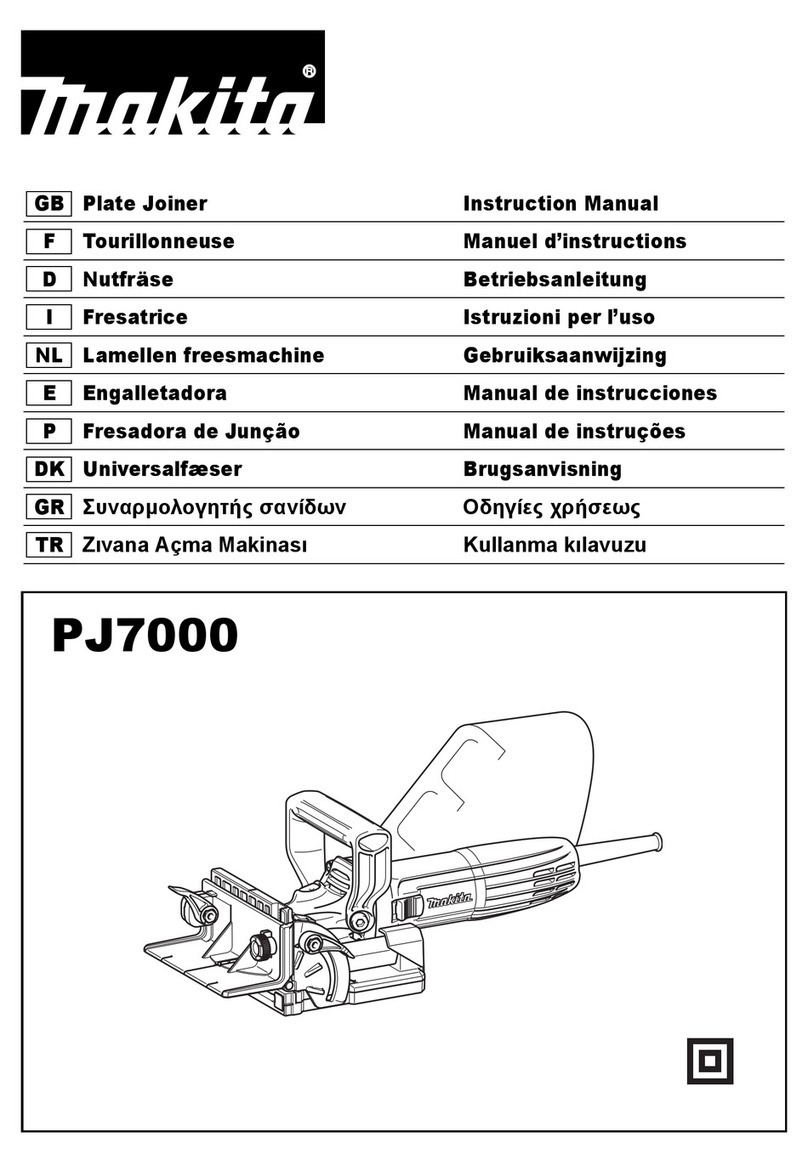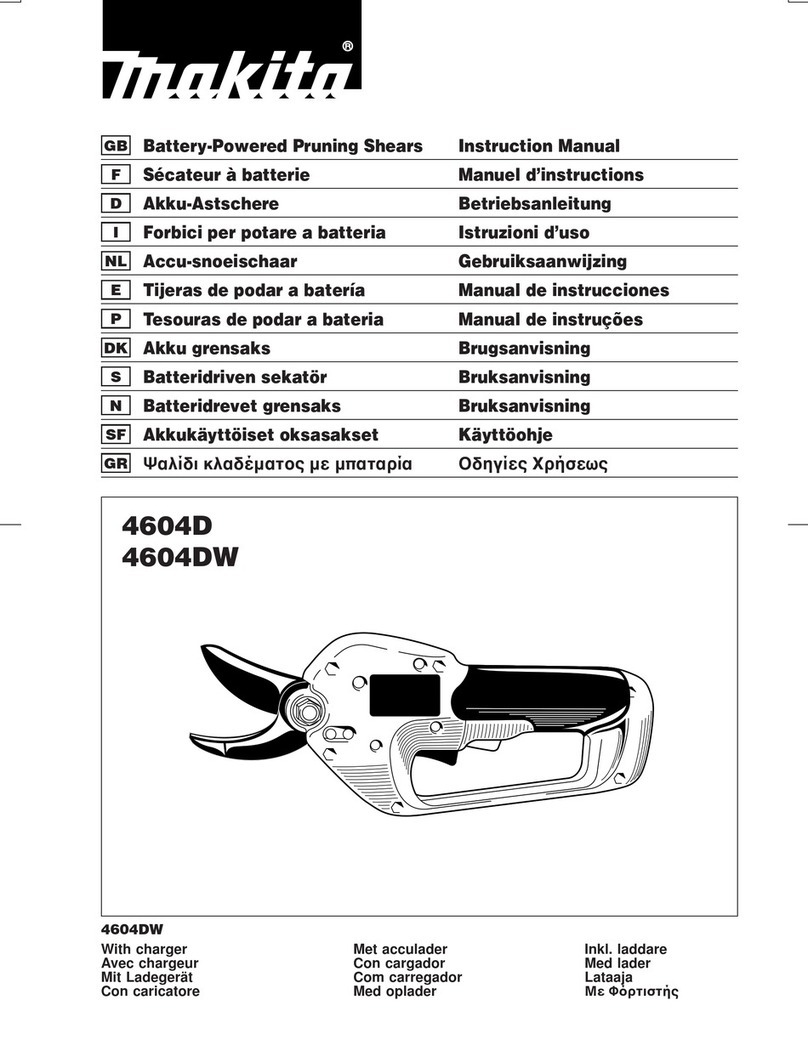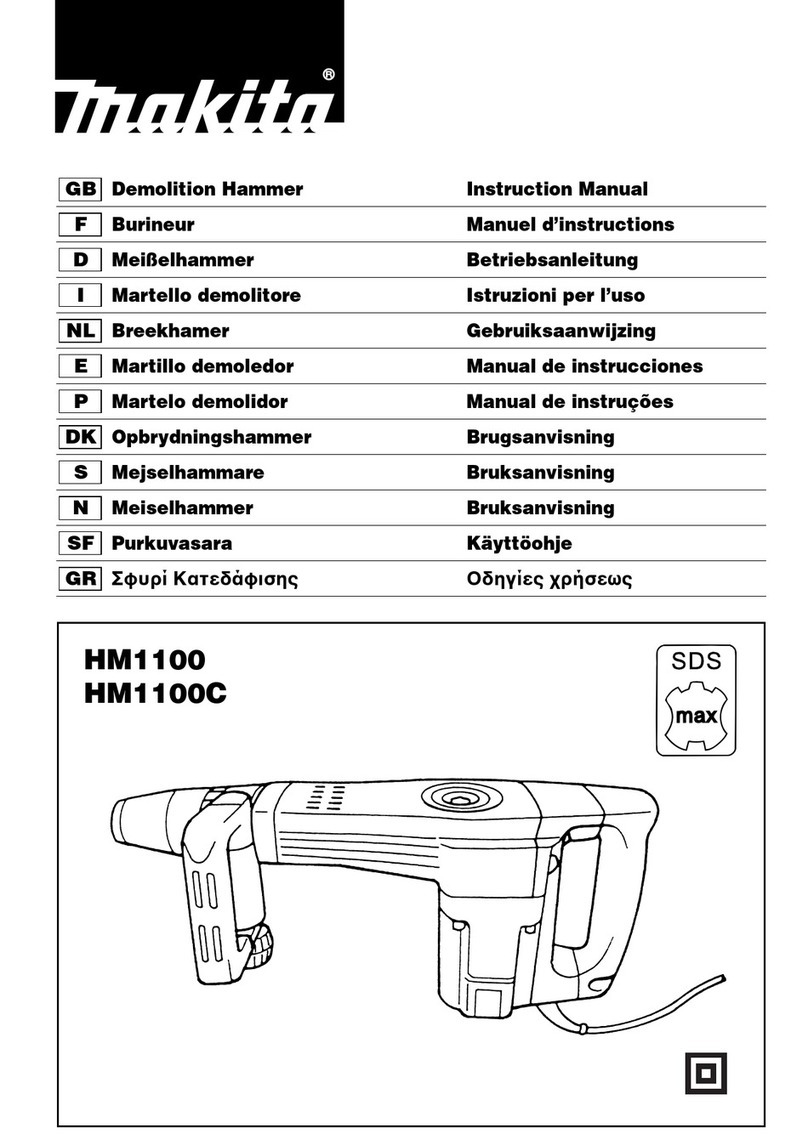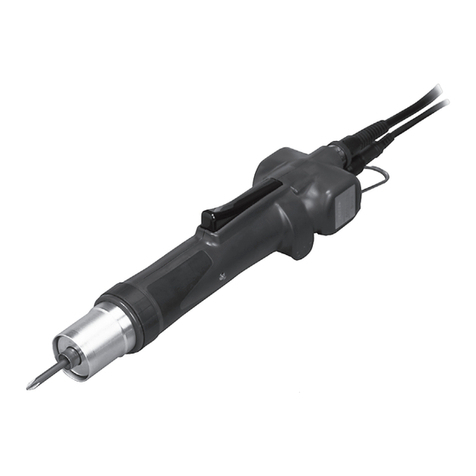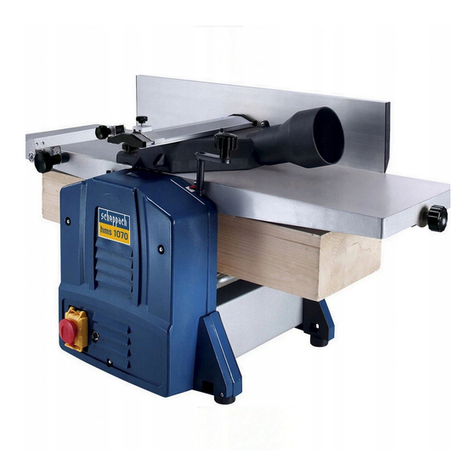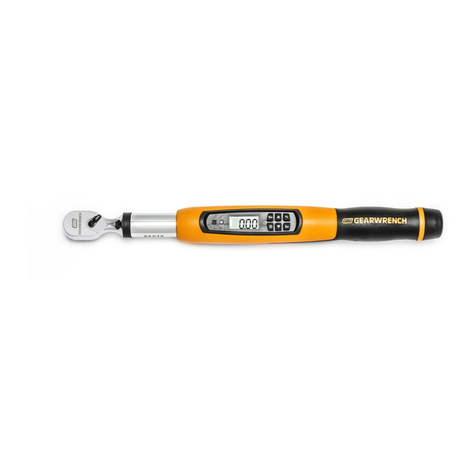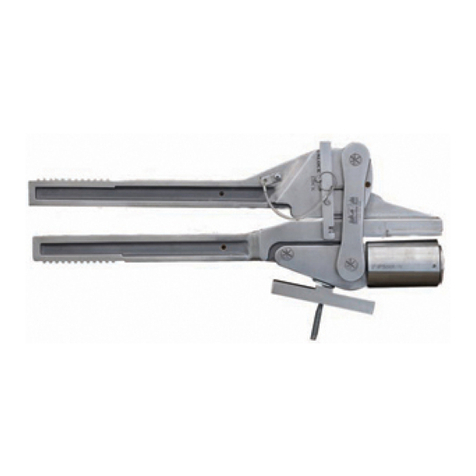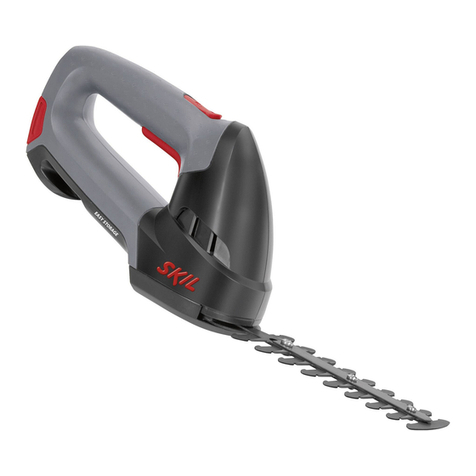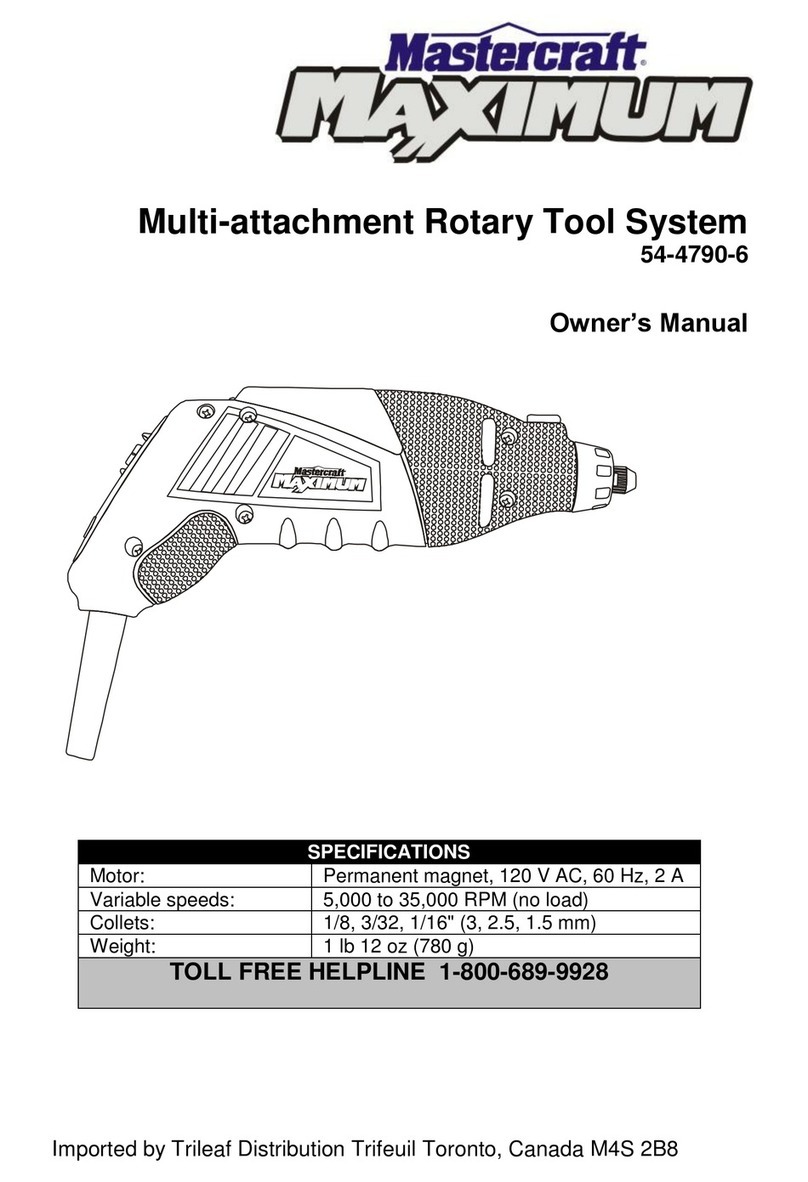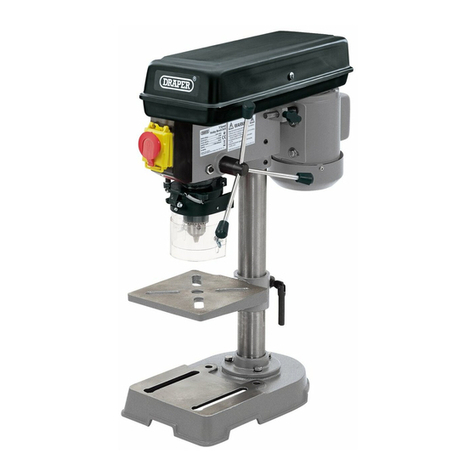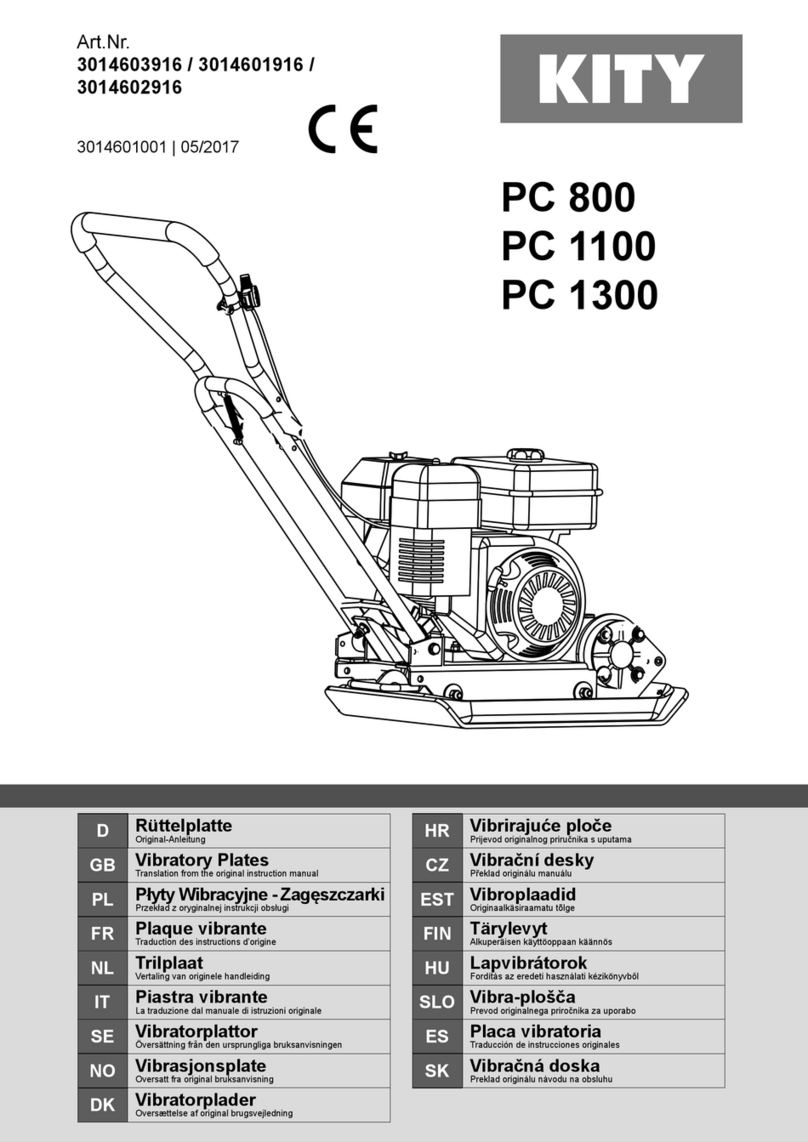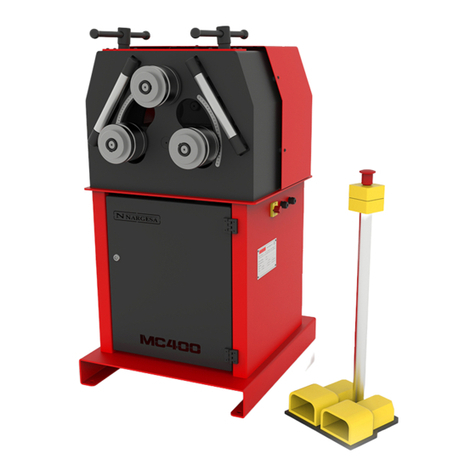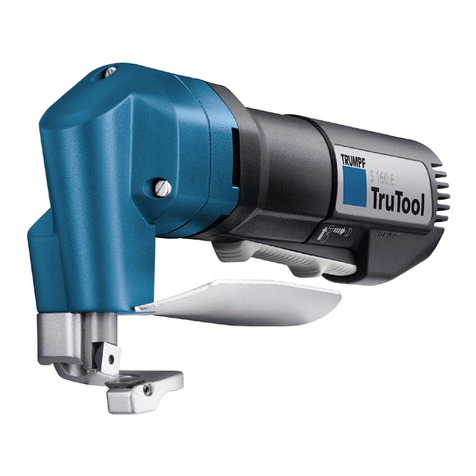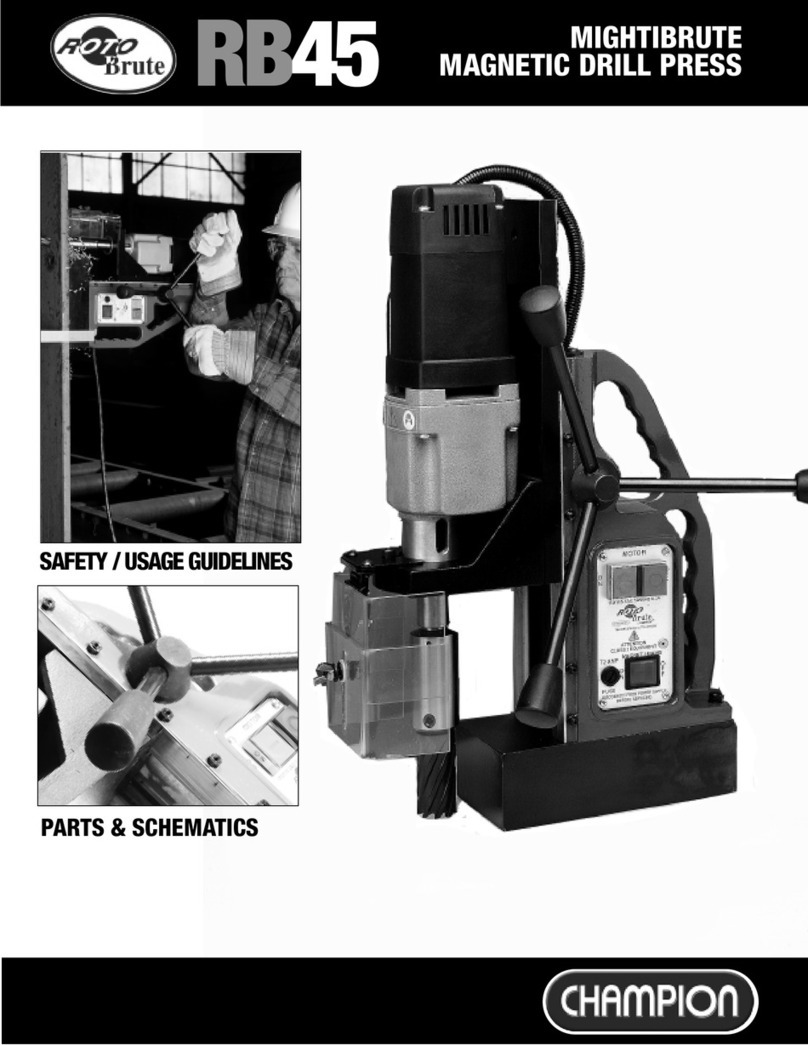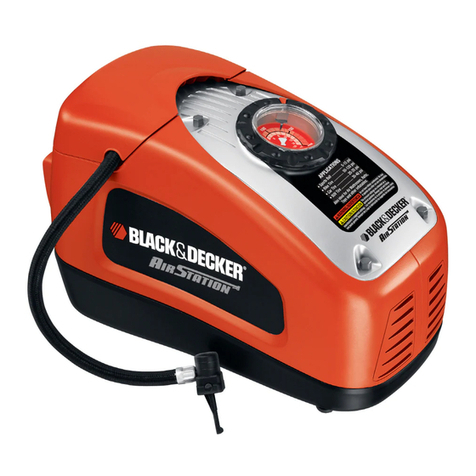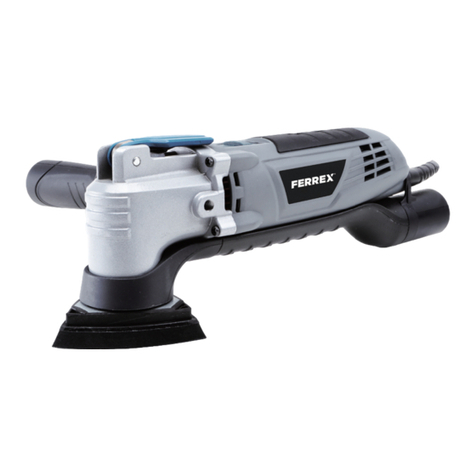Makita 6922NB User manual

GB Shear Wrench Instruction manual
ID Kunci Momen Geser
Petunjuk penggunaan
VI Maùy Sieát Caét Bu Loâng Caàm Taøi lieäu höôùng daãn
Tay Hoaït Ñoäng Baèng Ñoäng
Cô Ñieän
TH
6922NB
004982

2
1000114 2004983
3004984 4004985
5004986 6004987
1
2
3
4
5
2
6
7
8
2
5
4

3
7004988 8004989
9004990 10 004991
11 004992 12 004993
9
2
3
4
10
2
11
12
10
2
10

4
13 004994 14 005848
15 007539 16 001145
17 004995
13
14
11 15
16
17
18
19
20
21
22

5
ENGLISH (Original instructions)
Explanation of general view
SPECIFICATIONS
• Due to our continuing program of research and development, the specifications herein are subject to change without
notice.
• Specifications may differ from country to country.
• Weight according to EPTA-Procedure 01/2014
Symbols END201-7
The following show the symbols used for the equipment.
Be sure that you understand their meaning before use.
...... Read instruction manual.
................ DOUBLE INSULATION
Intended use ENE038-1
The tool is intended for fastening “tor-shear type” high
tensile bolts.
Power supply ENF002-2
The tool should be connected only to a power supply of
the same voltage as indicated on the nameplate, and can
only be operated on single-phase AC supply. They are
double-insulated and can, therefore, also be used from
sockets without earth wire.
General power tool safety
warnings GEA012-2
WARNING: Read all safety warnings, instructions,
illustrations and specifications provided with this
power tool. Failure to follow all instructions listed below
may result in electric shock, fire and/or serious injury.
Save all warnings and
instructions for future reference.
The term “power tool” in the warnings refers to your
mains-operated (corded) power tool or battery-operated
(cordless) power tool.
Work area safety
1. Keep work area clean and well lit. Cluttered or dark
areas invite accidents.
2. Do not operate power tools in explosive
atmospheres, such as in the presence of
flammable liquids, gases or dust. Power tools
create sparks which may ignite the dust or fumes.
3. Keep children and bystanders away while
operating a power tool. Distractions can cause you
to lose control.
Electrical Safety
1. Power tool plugs must match the outlet. Never
modify the plug in any way. Do not use any
adapter plugs with earthed (grounded) power
tools. Unmodified plugs and matching outlets will
reduce risk of electric shock.
2. Avoid body contact with earthed or grounded
surfaces, such as pipes, radiators, ranges and
refrigerators. There is an increased risk of electric
shock if your body is earthed or grounded.
3. Do not expose power tools to rain or wet
conditions. Water entering a power tool will increase
the risk of electric shock.
4. Do not abuse the cord. Never use the cord for
carrying, pulling or unplugging the power tool.
Keep cord away from heat, oil, sharp edges or
moving parts. Damaged or entangled cords increase
the risk of electric shock.
5. When operating a power tool outdoors, use an
extension cord suitable for outdoor use. Use of a
cord suitable for outdoor use reduces the risk of
electric shock.
6. If operating a power tool in a damp location is
unavoidable, use a residual current device (RCD)
1. Switch trigger
2. Outer sleeve
3. Screw
4. Inner sleeve
5. Pin
6. Tip rod
7. Tip rod spring
8. Inner sleeve spring
9. There should be no gap between
the outer sleeve and the tool.
10. Bolt tip
11. Nut
12. Notched portion
13. Tip ejector (Tip lever)
14. Identification mark
15. Bolt
16. Chamfered
17. Washer
18. Remaining length
19. Limit mark
20. Screwdriver
21. Brush holder cap
22. Protector
Model 6922NB
Bolt size M16, M20, M22
Max. normal torque 803.6 N·m
No load speed (min-1) 18 or 20 (country specific)
Dimensions (L x W x H) 249 mm x 84 mm x 252 mm
Net weight 4.9 kg
Safety class /II

6
protected supply. Use of an RCD reduces the risk of
electric shock.
7. Use of power supply via an RCD with a rated
residual current of 30 mA or less is always
recommended.
8. Power tools can produce electromagnetic fields
(EMF) that are not harmful to the user. However,
users of pacemakers and other similar medical
devices should contact the maker of their device and/
or doctor for advice before operating this power tool.
9. Do not touch the power plug with wet hands.
10. If the cord is damaged, have it replaced by the
manufacturer or his agent in order to avoid a
safety hazard.
Personal Safety
1. Stay alert, watch what you are doing and use
common sense when operating a power tool. Do
not use a power tool while you are tired or under
the influence of drugs, alcohol or medication. A
moment of inattention while operating power tools
may result in serious personal injury.
2. Use personal protective equipment. Always wear
eye protection. Protective equipment such as a dust
mask, non-skid safety shoes, hard hat or hearing
protection used for appropriate conditions will reduce
personal injuries.
3. Prevent unintentional starting. Ensure the switch
is in the off-position before connecting to power
source and/or battery pack, picking up or carrying
the tool. Carrying power tools with your finger on the
switch or energising power tools that have the switch
on invites accidents.
4. Remove any adjusting key or wrench before
turning the power tool on. A wrench or a key left
attached to a rotating part of the power tool may result
in personal injury.
5. Do not overreach. Keep proper footing and
balance at all times. This enables better control of
the power tool in unexpected situations.
6. Dress properly. Do not wear loose clothing or
jewellery. Keep your hair and clothing away from
moving parts. Loose clothes, jewellery or long hair
can be caught in moving parts.
7. If devices are provided for the connection of dust
extraction and collection facilities, ensure these
are connected and properly used. Use of dust
collection can reduce dust-related hazards.
8. Do not let familiarity gained from frequent use of
tools allow you to become complacent and ignore
tool safety principles. A careless action can cause
severe injury within a fraction of a second.
9. Always wear protective goggles to protect your
eyes from injury when using power tools. The
goggles must comply with ANSI Z87.1 in the USA,
EN 166 in Europe, or AS/NZS 1336 in Australia/
New Zealand. In Australia/New Zealand, it is
legally required to wear a face shield to protect
your face, too. (Fig. 1)
It is an employer’s responsibility to enforce the
use of appropriate safety protective equipments
by the tool operators and by other persons in the
immediate working area.
Power tool use and care
1. Do not force the power tool. Use the correct power
tool for your application. The correct power tool will
do the job better and safer at the rate for which it was
designed.
2. Do not use the power tool if the switch does not
turn it on and off. Any power tool that cannot be
controlled with the switch is dangerous and must be
repaired.
3. Disconnect the plug from the power source and/or
remove the battery pack, if detachable, from the
power tool before making any adjustments,
changing accessories, or storing power tools.
Such preventive safety measures reduce the risk of
starting the power tool accidentally.
4. Store idle power tools out of the reach of children
and do not allow persons unfamiliar with the
power tool or these instructions to operate the
power tool. Power tools are dangerous in the hands
of untrained users.
5. Maintain power tools and accessories. Check for
misalignment or binding of moving parts,
breakage of parts and any other condition that
may affect the power tool’s operation. If damaged,
have the power tool repaired before use. Many
accidents are caused by poorly maintained power
tools.
6. Keep cutting tools sharp and clean. Properly
maintained cutting tools with sharp cutting edges are
less likely to bind and are easier to control.
7. Use the power tool, accessories and tool bits etc.
in accordance with these instructions, taking into
account the working conditions and the work to
be performed. Use of the power tool for operations
different from those intended could result in a
hazardous situation.
8. Keep handles and grasping surfaces dry, clean
and free from oil and grease. Slippery handles and
grasping surfaces do not allow for safe handling and
control of the tool in unexpected situations.
9. When using the tool, do not wear cloth work
gloves which may be entangled. The entanglement
of cloth work gloves in the moving parts may result in
personal injury.
Service
1. Have your power tool serviced by a qualified
repair person using only identical replacement
parts. This will ensure that the safety of the power tool
is maintained.
2. Follow instruction for lubricating and changing
accessories.
SHEAR WRENCH SAFETY RULES
GEB161-1
1. Hold the power tool by insulated gripping
surfaces, when performing an operation where the
fastener may contact hidden wiring or its own
cord. Fasteners contacting a “live” wire may make
exposed metal parts of the power tool “live” and could
give the operator an electric shock.
2. Before using power tool, make sure that the outer
sleeve smoothly turns by hand. When it does not

7
smoothly turn, never use it and ask MAKITA
Authorized Service Center for check and repair.
3. When sheared bolt tip falls without moving tip
ejector (tip lever), never use it and ask MAKITA
Authorized Service Center for check and repair.
4. Always be sure you maintain good balance and
firm footing.
Be sure no one is below when using the tool in
high or elevated locations.
5. Hold the tool firmly.
6. Use care and common sense when disposing of
sheared bolt tips. Falling tips from high locations
or scattered tips can cause severe injury.
SAVE THESE INSTRUCTIONS.
WARNING:
DO NOT let comfort or familiarity with product (gained
from repeated use) replace strict adherence to shear
wrench safety rules for the subject product. MISUSE
or failure to follow the safety rules stated in this
instruction manual may cause serious personal
injury.
FUNCTIONAL DESCRIPTION
CAUTION:
• Always be sure that the tool is switched off and
unplugged before adjusting or checking function on the
tool.
Switch action (Fig. 2)
CAUTION:
• Before plugging in the tool, always check to see that
the switch trigger actuates properly and returns to the
“OFF” position when released.
To start the tool, simply pull the switch trigger. Release
the switch trigger to stop.
ASSEMBLY
CAUTION:
• Always be sure that the tool is switched off and
unplugged before carrying out any work on the tool.
Removing the outer and inner sleeves
(Fig. 3)
CAUTION:
• Be careful not to allow foreign matter to enter the
insides of the tool when removing or installing the outer
and inner sleeves.
If you need, for your work, different sizes of outer sleeve
and inner sleeve from those installed on your tool, replace
the sleeves as follows.
Loosen the two screws while holding the outer sleeve.
The outer and inner sleeves will be pushed up by the
springs built into the tool.
Press the pin down to remove the inner sleeve from the
outer sleeve. Be careful not to drop the inner sleeve when
removing it. Do not remove the inner sleeve spring, tip rod
and tip rod spring from the tool. (Fig. 4 & 5)
Installing the outer and inner sleeves
Hold the inner sleeve with the pin facing upward. Place
the outer sleeve over the inner sleeve. Press the pin to
allow inserting the inner sleeve, then release the pin to
secure the inner sleeve. (Fig. 6)
Insert the outer and inner sleeves into the tool while
rotating the inner sleeve alternately clockwise and
counterclockwise until there is no gap between the outer
sleeve and the tool. See the figure. Then tighten the two
screws securely. (Fig. 7)
OPERATION
Bolt installation
Slip the tool onto the bolt so that the inner sleeve
completely covers the bolt tip. (Fig. 8)
CAUTION:
• Be careful when fitting the sleeve onto the bolt tip.
Striking the tip can damage it so that it will no longer fit
inside the sleeve properly.
• First tighten bolts preliminarily by using a hand wrench
and then tighten them with this tool. Use this tool only
after preliminary tightening without starting the
tightening with this tool.
Keep forward pressure on the tool while sliding it further
forward until the outer sleeve fits completely over the nut.
If the tool fails to fit completely over the nut, twist the tool
slightly right and left while pushing forward. (Fig. 9)
Pull the switch trigger. The outer sleeve turns to begin
tightening the nut.
When the specified torque is attained, the bolt tip will be
sheared at its notched portion. The bolt tip will remain
inside the inner sleeve. (Fig. 10)
Release the switch trigger and withdraw the tool in a
straight line. (Fig. 11)
CAUTION:
• Do not force the tool down excessively. Apply the
downward force to the degree just needed to hold the
tool firm.
Pull the tip ejector (tip lever) to eject the bolt tip from the
tool. Catch the sheared bolt tips to prevent them from
falling dangerously below. Keep the tips off of the ground,
floor, walkways, etc. to prevent injury from tripping or
falling. (Fig. 12 & 13)
CAUTION:
• Washer and nut have head and tail. Head has
identification mark for nut and chamfer for washer.
When placing them, be careful not to place in reverse.
(Fig. 14)
CAUTION:
• Replace nut, bolt and washer all together at one time
when these rotate together, nut rotates excessively or
a bolt protrude from nut surface too much or less.
• Do not reuse used nut, bolt and washer.
• Choose shear bolts according to the thickness of
workpiece to be fastened. Range for the remaining
length of bolts that are obtained after cutting off chips
are determined by bolt size. Refer to the table below for
details. (Fig. 15)

8
CAUTION:
• Use bolts with the remaining length within the range
shown in the table above as bolts with different size
have different maximum and minimum remaining
length. Be careful not to use bolts beyond the specified
range which causes the tool damage.
MAINTENANCE
CAUTION:
• Always be sure that the tool is switched off and
unplugged before attempting to perform inspection or
maintenance.
• Never use gasoline, benzine, thinner, alcohol or the
like. Discoloration, deformation or cracks may result.
Replacing carbon brushes (Fig. 16)
Remove and check the carbon brushes regularly. Replace
when they wear down to the limit mark. Keep the carbon
brushes clean and free to slip in the holders. Both carbon
brushes should be replaced at the same time. Use only
identical carbon brushes.
Open the protector. Use a screwdriver to remove the
brush holder caps. Take out the worn carbon brushes,
insert the new ones and secure the brush holder caps.
(Fig. 17)
To maintain product SAFETY and RELIABILITY, repairs,
any other maintenance or adjustment should be
performed by Makita Authorized Service Centers, always
using Makita replacement parts.
OPTIONAL ACCESSORIES
CAUTION:
• These accessories or attachments are recommended
for use with your Makita tool specified in this manual.
The use of any other accessories or attachments might
present a risk of injury to persons. Only use accessory
or attachment for its stated purpose.
If you need any assistance for more details regarding
these accessories, ask your local Makita Service Center.
NOTE:
• Some items in the list may be included in the tool
package as standard accessories. They may differ
from country to country.
Bolt size Maximum
remainig length
Minimum
remainig length
M16 20 mm 4.5 mm
M20 15 mm 5.5 mm
M22 14 mm 7 mm
Sleeve Bolt size Lengh (mm)
Outer sleeve M16 35
Inner sleeve M16 36
Outer sleeve M20 37
Inner sleeve M20 38
Outer sleeve M22 39
Inner sleeve M22 39
Outer sleeve M22 85
Inner sleeve M22 85
Outer sleeve 5/8” 35
Inner sleeve 5/8” 36
Outer sleeve 3/4” 37
Inner sleeve 3/4” 38
Outer sleeve 3/4” 83
Inner sleeve 3/4” 84

9
BAHASA INDONESIA (Petunjuk Asli)
Penjelasan tampilan keseluruhan
SPESIFIKASI
• Karena kesinambungan program penelitian dan pengembangan kami, spesifikasi yang disebutkan di sini dapat
berubah tanpa pemberitahuan.
• Spesifikasi dapat berbeda dari satu negara ke negara lainnya.
• Berat menurut Prosedur EPTA 01/2014
Simbol-simbol END201-7
Berikut ini adalah simbol-simbol yang digunakan pada
alat ini. Pastikan Anda mengerti makna masing-masing
simbol sebelum menggunakan alat ini.
...... Baca petunjuk penggunaan.
................ ISOLASI GANDA
Maksud penggunaan ENE038-1
Alat ini dimaksudkan untuk mengencangkan baut mutu
tinggi (tensil tinggi) “tipe tor-shear”.
Pasokan daya ENF002-2
Alat harus terhubung dengan pasokan daya listrik yang
bervoltase sama dengan yang tertera pada pelat nama,
dan hanya dapat dijalankan dengan listrik AC fase
tunggal. Alat ini diisolasi ganda dan oleh sebab itu dapat
dihubungkan dengan soket tanpa arde.
Peringatan keselamatan umum
mesin listrik GEA012-2
PERINGATAN: Bacalah semua peringatan
keselamatan, petunjuk, ilustrasi dan spesifikasi yang
disertakan bersama mesin listrik ini. Kelalaian untuk
mematuhi semua petunjuk yang tercantum di bawah ini
dapat menyebabkan sengatan listrik, kebakaran dan/atau
cedera serius.
Simpanlah semua peringatan dan
petunjuk untuk acuan di masa depan.
Istilah “mesin listrik” dalam semua peringatan mengacu
pada mesin listrik yang dijalankan dengan sumber listrik
jala-jala (berkabel) atau baterai (tanpa kabel).
Keselamatan tempat kerja
1. Jaga tempat kerja selalu bersih dan
berpenerangan cukup. Tempat kerja yang
berantakan dan gelap mengundang kecelakaan.
2. Jangan gunakan mesin listrik dalam lingkungan
yang mudah meledak, misalnya jika ada cairan,
gas, atau debu yang mudah menyala. Mesin listrik
menimbulkan bunga api yang dapat menyalakan debu
atau uap tersebut.
3. Jauhkan anak-anak dan orang lain saat
menggunakan mesin listrik. Bila perhatian terpecah,
anda dapat kehilangan kendali.
Keamanan Kelistrikan
1. Steker mesin listrik harus cocok dengan
stopkontak. Jangan sekali-kali mengubah steker
dengan cara apa pun. Jangan menggunakan
steker adaptor dengan mesin listrik terbumi
(dibumikan). Steker yang tidak diubah dan
stopkontak yang cocok akan mengurangi risiko
sengatan listrik.
2. Hindari sentuhan tubuh dengan permukaan
terbumi atau yang dibumikan seperti pipa,
radiator, kompor, dan kulkas. Risiko sengatan listrik
bertambah jika tubuh Anda terbumikan atau
dibumikan.
3. Jangan membiarkan mesin listrik kehujanan atau
kebasahan. Air yang masuk ke dalam mesin listrik
akan meningkatkan risiko sengatan listrik.
4. Jangan menyalahgunakan kabel. Jangan sekali-
kali menggunakan kabel untuk membawa,
menarik, atau mencabut mesin listrik dari
stopkontak. Jauhkan kabel dari panas, minyak,
1. Picu sakelar
2. Selongsong luar
3. Sekrup
4. Selongsong dalam
5. Pasak
6. Batang ujung
7. Pegas batang ujung
8. Pegas selongsong dalam
9. Tidak boleh ada celah di antara
selongsong luar dan alat.
10. Ujung baut
11. M ur
12. Bagian bertakik
13. Pelontar ujung (Tuas ujung)
14. Tanda identifikasi
15. Baut
16. Bercamfer (segi dipangkas)
17. Cincin
18. Sisa panjang
19. Garis batas
20. Obeng
21. Tutup borstel arang
22. Pelindung
Model 6922NB
Ukuran baut M16, M20, M22
Torsi normal maks. 803,6 N·m
Kecepatan tanpa beban (men-1) 18 atau 20 (spesifik per negara)
Dimensi (P x L x T) 249 mm x 84 mm x 252 mm
Berat bersih 4,9 kg
Kelas keamanan /II

10
tepian tajam, atau bagian yang bergerak. Kabel yang
rusak atau kusut memperbesar risiko sengatan listrik.
5. Bila menggunakan mesin listrik di luar ruangan,
gunakan kabel ekstensi yang sesuai untuk
penggunaan di luar ruangan. Penggunaan kabel
yang sesuai untuk penggunaan luar ruangan
mengurangi risiko sengatan listrik.
6. Jika mengoperasikan mesin listrik di lokasi
lembap tidak terhindarkan, gunakan pasokan daya
yang dilindungi peranti imbasan arus (residual
current device - RCD). Penggunaan RCD
mengurangi risiko sengatan listrik.
7. Penggunaan pasokan daya melalui RCD dengan
kapasitas arus sisa 30 mA atau kurang selalu
dianjurkan.
8. Mesin listrik dapat menghasilkan medan magnet
(EMF) yang tidak berbahaya bagi pengguna.
Namun, pengguna alat pacu jantung atau peralatan
medis sejenisnya harus berkonsultasi dengan
produsen peralatan tersebut dan/atau dokter mereka
sebelum mengoperasikan mesin listrik ini.
9. Jangan menyentuh colokan daya dengan tangan
basah.
10. Jika kabel rusak, penggantian harus dilakukan
oleh produsen atau agennya untuk menghindari
bahaya keselamatan.
Keselamatan Diri
1. Jaga kewaspadaan, perhatikan pekerjaan Anda
dan gunakan akal sehat bila menggunakan mesin
listrik. Jangan menggunakan mesin listrik saat
Anda lelah atau di bawah pengaruh obat bius,
alkohol, atau obat. Sekejap saja lalai saat
menggunakan mesin listrik dapat menyebabkan
cedera badan serius.
2. Gunakan alat pelindung diri. Selalu gunakan
pelindung mata. Peralatan pelindung seperti masker
debu, sepatu pengaman anti-selip, helm pengaman,
atau pelindung telinga yang digunakan untuk kondisi
yang sesuai akan mengurangi risiko cedera badan.
3. Cegah penyalaan yang tidak disengaja. Pastikan
bahwa sakelar berada dalam posisi mati (off)
sebelum menghubungkan mesin ke sumber daya
dan/atau paket baterai, atau mengangkat atau
membawanya. Membawa mesin listrik dengan jari
Anda pada sakelarnya atau mengalirkan listrik pada
mesin listrik yang sakelarnya hidup (on) akan
mengundang kecelakaan.
4. Lepaskan kunci-kunci penyetel sebelum
menghidupkan mesin listrik. Kunci-kunci yang
masih terpasang pada bagian mesin listrik yang
berputar dapat menyebabkan cedera.
5. Jangan meraih terlalu jauh. Jagalah pijakan dan
keseimbangan sepanjang waktu. Hal ini
memungkinkan kendali yang lebih baik atas mesin
listrik dalam situasi yang tidak diharapkan.
6. Kenakan pakaian yang memadai. Jangan memakai
pakaian yang longgar atau perhiasan. Jaga jarak
antara rambut dan pakaian Anda dengan
komponen mesin yang bergerak. Pakaian yang
longgar, perhiasan, atau rambut yang panjang dapat
tersangkut pada komponen yang bergerak.
7. Jika tersedia fasilitas untuk menghisap dan
mengumpulkan debu, pastikan fasilitas tersebut
terhubung listrik dan digunakan dengan baik.
Penggunaan pembersih debu dapat mengurangi
bahaya yang terkait dengan debu.
8. Jangan sampai Anda lengah dan mengabaikan
prinsip keselamatan mesin ini hanya karena sudah
sering mengoperasikannya dan sudah merasa
terbiasa. Tindakan yang lalai dapat menyebabkan
cedera berat dalam sepersekian detik saja.
9. Selalu kenakan kacamata pelindung untuk
melindungi mata dari cedera saat menggunakan
mesin listrik. Kacamata harus sesuai dengan ANSI
Z87.1 di Amerika Serikat, EN 166 di Eropa, atau
AS/NZS 1336 di Australia/Selandia Baru. Di
Australia/Selandia Baru, secara hukum Anda juga
diwajibkan mengenakan pelindung wajah untuk
melindungi wajah Anda. (Gb. 1)
Menjadi tanggung jawab atasan untuk
menerapkan penggunaan alat pelindung
keselamatan yang tepat bagi operator mesin dan
orang lain yang berada di area kerja saat itu.
Penggunaan dan pemeliharaan mesin listrik
1. Jangan memaksa mesin listrik. Gunakan mesin
listrik yang tepat untuk keperluan Anda. Mesin
listrik yang tepat akan menuntaskan pekerjaan
dengan lebih baik dan aman pada kecepatan sesuai
rancangannya.
2. Jangan gunakan mesin listrik jika sakelar tidak
dapat menyalakan dan mematikannya. Mesin listrik
yang tidak dapat dikendalikan dengan sakelarnya
adalah berbahaya dan harus diperbaiki.
3. Cabut steker dari sumber listrik dan/atau lepas
paket baterai, jika dapat dilepas, dari mesin listrik
sebelum melakukan penyetelan apa pun,
mengganti aksesori, atau menyimpan mesin
listrik. Langkah keselamatan preventif tersebut
mengurangi risiko hidupnya mesin secara tak
sengaja.
4. Simpan mesin listrik jauh dari jangkauan anak-
anak dan jangan biarkan orang yang tidak paham
mengenai mesin listrik tersebut atau petunjuk ini
menggunakan mesin listrik. Mesin listrik sangat
berbahaya di tangan pengguna yang tak terlatih.
5. Rawatlah mesin listrik dan aksesori. Periksa
apakah ada komponen bergerak yang tidak lurus
atau macet, komponen yang pecah, dan kondisi-
kondisi lain yang dapat memengaruhi
pengoperasian mesin listrik. Jika rusak, perbaiki
dahulu mesin listrik sebelum digunakan. Banyak
kecelakaan disebabkan oleh kurangnya pemeliharaan
mesin listrik.
6. Jaga agar mesin pemotong tetap tajam dan bersih.
Mesin pemotong yang terawat baik dengan mata
pemotong yang tajam tidak mudah macet dan lebih
mudah dikendalikan.
7. Gunakan mesin listrik, aksesori, dan mata mesin,
dll. sesuai dengan petunjuk ini, dengan
memperhitungkan kondisi kerja dan jenis
pekerjaan yang dilakukan. Penggunaan mesin listrik
untuk penggunaan yang lain dari peruntukan dapat
menimbulkan situasi berbahaya.
8. Jagalah agar gagang dan permukaan pegangan
tetap kering, bersih, dan bebas dari minyak dan
pelumas. Gagang dan permukaan pegangan yang
licin tidak mendukung keamanan penanganan dan
pengendalian mesin dalam situasi-situasi tak terduga.

11
9. Ketika menggunakan mesin, jangan
menggunakan sarung tangan kain yang dapat
tersangkut. Sarung tangan kain yang tersangkut
pada komponen bergerak dapat mengakibatkan
cedera pada pengguna.
Servis
1. Berikan mesin listrik untuk diperbaiki hanya
kepada oleh teknisi yang berkualifikasi dengan
menggunakan hanya suku cadang pengganti yang
serupa. Hal ini akan menjamin terjaganya keamanan
mesin listrik.
2. Patuhi petunjuk pelumasan dan penggantian
aksesori.
KAIDAH KESELAMATAN KUNCI
MOMEN GESER GEB161-1
1. Pegang alat listrik pada permukaan genggam yang
terisolasi bila dalam melakukan pekerjaan,
pengencang mungkin bersentuhan dengan kawat
tersembunyi atau kabelnya sendiri. Pengencang
yang menyentuh kawat “hidup” dapat menyebabkan
bagian logam yang terbuka pada alat listrik ini teraliri
arus listrik dan menyengat pengguna.
2. Sebelum menggunakan mesin listrik, pastikan
bahwa selongsong luar dapat dengan mudah
diputar dengan tangan. Jika tidak dapat diputar
dengan mudah, jangan sekali-kali menggunakan
mesin listrik ini, dan mintalah Pusat Servis Resmi
MAKITA untuk memeriksa dan memperbaikinya.
3. Jika ujung baut yang telah terputus terjatuh tanpa
harus menggerakkan pelontar ujung (tuas ujung),
jangan sekali-kali menggunakan mesin listrik ini,
dan mintalah Pusat Servis Resmi MAKITA untuk
memeriksa dan memperbaikinya.
4. Selalu pastikan Anda menjaga keseimbangan
dengan baik dan berdiri di atas alas pijakan yang
kuat.
Pastikan tidak ada orang di bawahnya bila Anda
menggunakan alat ini di tempat yang tinggi atau
ditinggikan.
5. Pegang alat dengan kuat.
6. Berhati-hati dan gunakanlah akal sehat saat
membuang ujung baut yang telah terputus. Ujung
baut yang jatuh dari tempat tinggi atau yang
berceceran dapat menyebabkan cedera parah.
SIMPAN PETUNJUK INI.
PERINGATAN:
JANGAN biarkan kenyamanan atau terbiasanya Anda
dengan produk (karena penggunaan berulang)
menggantikan kepatuhan yang ketat terhadap aturan
keselamatan untuk kunci momen geser.
PENYALAHGUNAAN atau kelalaian mematuhi kaidah
keselamatan yang tertera dalam petunjuk
penggunaan ini dapat menyebabkan cedera badan
serius.
DESKRIPSI FUNGSI
PERHATIAN:
• Selalu pastikan alat sudah dimatikan dan stekernya
dicabut sebelum menyetel atau memeriksa fungsi alat.
Gerakan sakelar (Gb. 2)
PERHATIAN:
• Sebelum menancapkan steker alat, selalu pastikan
bahwa picu sakelar bekerja dengan baik dan kembali
ke posisi “OFF” saat dilepaskan.
Untuk menyalakan alat, cukup tarik picu sakelarnya.
Lepaskan picu sakelar untuk menghentikannya.
PERAKITAN
PERHATIAN:
• Selalu pastikan mesin sudah dimatikan dan stekernya
dicabut sebelum melakukan pekerjaan apa pun pada
mesin.
Melepas selongsong luar dan dalam
(Gb. 3)
PERHATIAN:
• Berhati-hatilah untuk tidak membiarkan benda asing
masuk ke dalam alat saat melepas atau memasang
selongsong (soket) luar dan dalam.
Jika karena kebutuhan pekerjaan Anda membutuhkan
ukuran selongsong luar dan selongsong dalam yang
berbeda dengan yang terpasang pada alat, gantilah
selongsong seperti berikut.
Kendurkan kedua sekrup sambil menahan selongsong
luar. Selongsong luar dan dalam akan terdorong ke atas
oleh pegas yang tertanam pada alat.
Tekan pasaknya ke bawah untuk melepaskan selongsong
dalam dari selongsong luar. Berhati-hatilah untuk tidak
menjatuhkan selongsong dalam saat melepaskannya.
Jangan melepaskan pegas selongsong dalam, batang
ujung, dan pegas batang ujung dari alat. (Gb. 4 & 5)
Memasang selongsong luar dan dalam
Tahan selongsong dalam dengan pasak menghadap ke
atas. Tempatkan selongsong luar di atas selongsong
dalam. Tekan pasak untuk memungkinkan pemasukan
selongsong dalam, kemudian lepaskan tekanan pada
pasak untuk mengencangkan selongsong dalam. (Gb. 6)
Masukkan selongsong luar dan dalam ke dalam alat
sambil memutar selongsong dalam bergantian searah
jarum jam dan berlawanan arah jarum jam sampai tidak
ada lagi celah antara selongsong luar dan alat. Lihat
gambar. Kemudian kencangkan kedua sekrupnya kuat-
kuat. (Gb. 7)
PENGOPERASIAN
Pemasangan baut
Paskan alat di atas baut sehingga selongsong (soket)
dalam sepenuhnya memegang ujung baut. (Gb. 8)
PERHATIAN:
• Berhati-hatilah saat mengepaskan selongsong dengan
ujung baut. Menghantam ujung baut dapat
membuatnya rusak sehingga ujung baut tidak akan
dapat tercengkeram pas lagi di dalam selongsong.
• Terlebih dahulu kencangkanlah baut dengan kunci pas
manual dan baru kemudian kencangkan dengan alat
ini. Gunakan alat ini hanya setelah baut dikencangkan
lebih dahulu tanpa pengencangan dengan alat ini.

12
Jaga tekanan maju pada alat sambil mendorongnya maju
lebih jauh sampai selongsong (soket) luar sepenuhnya
memegang mur. Jika alat belum sepenuhnya memegang
mur dengan pas, puntir alat sedikit ke kanan dan kiri
sambil mendorongnya maju. (Gb. 9)
Tarik picu sakelar. Selongsong luar berputar untuk mulai
mengencangkan mur.
Saat torsi yang ditentukan tercapai, ujung baut akan
terputus (tergeser) pada bagian bertakiknya. Ujung baut
akan tetap berada di dalam selongsong dalam. (Gb. 10)
Lepaskan picu sakelar dan tarik mundur alat dalam garis
lurus. (Gb. 11)
PERHATIAN:
• Jangan memaksa menekan alat secara berlebihan.
Berikan tenaga ke bawah hanya sebesar yang
diperlukan untuk menahan alat dengan kuat.
Tarik pelontar ujung (tuas ujung) untuk melontarkan ujung
baut dari alat. Tangkap ujung baut yang telah terputus itu
agar tidak jatuh ke bawah dan menimbulkan bahaya.
Jangan biarkan ujung baut berserakan di atas tanah,
lantai, trotoar, dll. agar tidak menimbulkan cedera akibat
terpeleset atau terjatuh. (Gb. 12 & 13)
PERHATIAN:
• Cincin dan mur memiliki kepala dan ekor. Bagian
kepala ditandai dengan tanda identifikasi untuk mur
dan camfer (segi dipangkas) untuk cincin. Saat
memasangnya, hati-hatilah agar tidak memasang
secara terbalik. (Gb. 14)
PERHATIAN:
• Ganti mur, baut, dan cincin semuanya sekaligus bila
semuanya itu berputar bersama, mur berputar terlalu
banyak atau baut muncul dari permukaan mur terlalu
banyak atau terlalu sedikit.
• Jangan gunakan kembali mur, baut, dan cincin bekas.
• Pilihlah baut geser (shear bolt) sesuai dengan
ketebalan benda kerja yang akan dikencangkan.
Kisaran sisa panjang baut yang diperoleh setelah
ujungnya terputus ditentukan oleh ukuran baut. Lihat
tabel di bawah ini untuk detailnya. (Gb. 15)
PERHATIAN:
• Gunakan baut dengan sisa panjang berada dalam
kisaran yang diperlihatkan dalam tabel di atas karena
baut dengan ukuran berbeda memiliki sisa panjang
maksimum dan minimum yang berbeda. Berhati-
hatilah untuk tidak menggunakan baut di luar kisaran
yang ditentukan, yang menyebabkan kerusakan alat.
PERAWATAN
PERHATIAN:
• Selalu pastikan mesin sudah dimatikan dan stekernya
dicabut sebelum melakukan pemeriksaan atau
perawatan.
• Jangan sekali-kali menggunakan bensin, tiner, alkohol,
atau bahan sejenisnya. Penggunaan bahan demikian
dapat menyebabkan perubahan warna dan bentuk
serta timbulnya retakan.
Mengganti borstel arang (Gb. 16)
Lepaskan dan periksa borstel arang secara teratur. Ganti
bila borstel sudah aus mencapai garis batas. Jaga agar
borstel arang tetap bersih dan masuk lancar ke
tempatnya. Kedua borstel arang harus diganti secara
bersamaan. Gunakan hanya borstel arang yang identik.
Buka pelindung. Gunakan obeng untuk melepas tutup
borstel arang. Lepaskan borstel arang yang sudah aus,
masukkan borstel baru, dan kencangkan tutup borstel.
(Gb. 17)
Untuk menjaga KEAMANAN dan KEHANDALAN,
perbaikan, perawatan lain, atau penyetelan harus
dilakukan oleh Pusat Servis Resmi Makita dan gunakan
selalu suku cadang Makita.
AKSESORI TAMBAHAN
PERHATIAN:
• Aksesori atau alat tambahan ini dianjurkan untuk
digunakan dengan alat Makita milik Anda yang
disebutkan dalam buku petunjuk ini. Penggunaan
aksesori atau alat tambahan lain dapat menimbulkan
risiko cedera pada orang. Gunakan aksesori atau alat
tambahan sesuai kegunaannya.
Jika Anda membutuhkan bantuan perihal informasi lebih
terperinci mengenai aksesori-aksesori ini, tanyakan
kepada Pusat Servis Makita setempat.
Ukuran baut Sisa panjang
maksimum
Sisa panjang
minimum
M16 20 mm 4,5 mm
M20 15 mm 5,5 mm
M22 14 mm 7 mm

13
CATATAN:
• Beberapa artikel dalam daftar dapat disertakan dalam
kemasan mesin sebagai aksesori standar.
Kelengkapan ini dapat berbeda dari satu negara ke
negara lainnya.
Selongsong Ukuran baut Panjang (mm)
Selongsong luar M16 35
Selongsong
dalam M16 36
Selongsong luar M20 37
Selongsong
dalam M20 38
Selongsong luar M22 39
Selongsong
dalam M22 39
Selongsong luar M22 85
Selongsong
dalam M22 85
Selongsong luar 5/8” 35
Selongsong
dalam 5/8” 36
Selongsong luar 3/4” 37
Selongsong
dalam 3/4” 38
Selongsong luar 3/4” 83
Selongsong
dalam 3/4” 84

14
TIEÁNG VIEÄT (Höôùng daãn Goác)
Giaûi thích veà hình veõ toång theå
THOÂNG SOÁ KYÕ THUAÄT
•Do chöông trình nghieân cöùu vaø phaùt trieån lieân tuïc cuûa chuùng toâi neân caùc thoâng soá kyõ thuaät döôùi ñaây coù theå thay
ñoåi maø khoâng caàn thoâng baùo.
•Caùc thoâng soá kyõ thuaät ôû moãi quoác gia coù theå khaùc nhau.
•Troïng löôïng theo quy ñònh EPTA-Procedure 01/2014
Kyù hieäu END201-7
Phaàn döôùi ñaây cho bieát caùc kyù hieäu ñöôïc duøng cho
thieát bò. Ñaûm baûo raèng baïn hieåu yù nghóa cuûa caùc kyù
hieäu naøy tröôùc khi söû duïng.
...... Ñoïc taøi lieäu höôùng daãn.
............... CAÙCH ÑIEÄN KEÙP
Muïc ñích söû duïng ENE038-1
Duïng cuï naøy duøng ñeå sieát chaët buloâng cöôøng ñoä cao
“loaïi caét ñaàu”.
Nguoàn caáp ñieän ENF002-2
Duïng cuï naøy chæ ñöôïc noái vôùi nguoàn caáp ñieän coù ñieän
aùp gioáng nhö ñaõ chæ ra treân bieån teân vaø chæ coù theå ñöôïc
vaän haønh treân nguoàn cung caáp AC moät pha. Thieát bò
ñöôïc caùch ñieän keùp vaø do ñoù cuõng coù theå ñöôïc söû
duïng töø caùc oå caém maø khoâng caàn daây tieáp ñaát.
Caûnh baùo an toaøn chung daønh
cho duïng cuï maùy GEA012-2
CAÛNH BAÙO: Xin ñoïc taát caû caùc caûnh baùo an
toaøn, höôùng daãn, minh hoïa vaø thoâng soá kyõ thuaät ñi
keøm vôùi duïng cuï maùy naøy. Vieäc khoâng tuaân theo caùc
höôùng daãn ñöôïc lieät keâ döôùi ñaây coù theå daãn ñeán ñieän
giaät, hoûa hoaïn vaø/hoaëc thöông tích nghieâm troïng.
Löu giöõ taát caû caûnh baùo vaø
höôùng daãn ñeå tham khaûo sau
naøy.
Thuaät ngöõ “duïng cuï maùy” trong caùc caûnh baùo ñeà caäp
ñeán duïng cuï maùy (coù daây) ñöôïc vaän haønh baèng nguoàn
ñieän chính hoaëc duïng cuï maùy (khoâng daây) ñöôïc vaän
haønh baèng pin cuûa baïn.
An toaøn taïi nôi laøm vieäc
1. Giöõ nôi laøm vieäc saïch seõ vaø coù ñuû aùnh saùng. Nôi
laøm vieäc böøa boän hoaëc toái thöôøng deã gaây ra tai naïn.
2. Khoâng vaän haønh duïng cuï maùy trong moâi tröôøng
chaùy noå, ví duï nhö moâi tröôøng coù söï hieän dieän
cuûa caùc chaát loûng, khí hoaëc buïi deã chaùy. Caùc
duïng cuï maùy taïo tia löûa ñieän coù theå laøm buïi hoaëc
khí boác chaùy.
3. Giöõ treû em vaø ngöôøi ngoaøi traùnh xa nôi laøm vieäc
khi ñang vaän haønh duïng cuï maùy. Söï xao laõng coù
theå khieán baïn maát khaû naêng kieåm soaùt.
An toaøn veà Ñieän
1. Phích caém cuûa duïng cuï maùy phaûi khôùp vôùi oå
caém. Khoâng ñöôïc söûa ñoåi phích caém theo baát kyø
caùch naøo. Khoâng söû duïng baát kyø phích chuyeån
ñoåi naøo vôùi caùc duïng cuï maùy ñöôïc noái ñaát (tieáp
ñaát). Caùc phích caém coøn nguyeân veïn vaø oå caém phuø
hôïp seõ giaûm nguy cô ñieän giaät.
2. Traùnh ñeå cô theå tieáp xuùc vôùi caùc beà maët noái ñaát
hoaëc tieáp ñaát nhö ñöôøng oáng, boä taûn nhieät, beáp
ga vaø tuû laïnh. Nguy cô bò ñieän giaät seõ taêng leân neáu
cô theå baïn ñöôïc noái ñaát hoaëc tieáp ñaát.
3. Khoâng ñeå duïng cuï maùy tieáp xuùc vôùi möa hoaëc
trong ñieàu kieän aåm öôùt. Nöôùc loït vaøo duïng cuï
maùy seõ laøm taêng nguy cô ñieän giaät.
1. Boä khôûi ñoäng coâng taéc
2. OÁng loàng ngoaøi
3. Vít
4. OÁng loàng trong
5. OÁng
6. Caàn noái ñaàu
7. Loø xo caàn noái ñaàu
8. Loø xo oáng loàng trong
9. Khoâng neân coù khoaûng troáng
giöõa oáng loàng ngoaøi vaø duïng cuï.
10. Ñaàu buloâng
11. Ñai oác
12. Phaàn caét khaác
13. Caàn ñaåy ñaàu (Caàn gaït ñaàu)
14. Kö hieäu quy öôùc
15. Bu-loâng
16. Vaùt caïnh
17. Voøng ñeäm
18. Ñoä daøi coøn laïi
19. Vaïch giôùi haïn
20. Tua vít
21. Naép giaù ñôõ choåi than
22. Taám baûo veä
Kieåu maùy 6922NB
Kích thöôùc buloâng M16, M20, M22
Löïc xoaén cöïc ñaïi thoâng thöôøng 803,6 N·m
Toác ñoä khoâng taûi (min-1) 18 hoaëc 20 (cuï theå theo quoác gia)
Kích thöôùc (D x R x C) 249 mm x 84 mm x 252 mm
Troïng löôïng tònh 4,9 kg
Caáp an toaøn /II

15
4. Khoâng laïm duïng daây ñieän. Khoâng ñöôïc pheùp söû
duïng daây ñeå mang, keùo hoaëc thaùo phích caém
duïng cuï maùy. Giöõ daây traùnh xa nguoàn nhieät,
daàu, caùc meùp saéc hoaëc caùc boä phaän ñoäng
chuyeån ñoäng. Daây bò hoûng hoaëc bò roái seõ laøm taêng
nguy cô ñieän giaät.
5. Khi vaän haønh duïng cuï maùy ngoaøi trôøi, haõy söû
duïng daây keùo daøi phuø hôïp cho vieäc söû duïng
ngoaøi trôøi. Vieäc duøng daây phuø hôïp cho vieäc söû
duïng ngoaøi trôøi seõ giaûm nguy cô ñieän giaät.
6. Neáu baét buoäc phaûi vaän haønh duïng cuï maùy ôû nôi
aåm öôùt, haõy söû duïng nguoàn caáp ñieän ñöôïc baûo
veä baèng thieát bò ngaét doøng ñieän roø (RCD). Vieäc
söû duïng RCD seõ laøm giaûm nguy cô ñieän giaät.
7. Chuùng toâi luoân khuyeân baïn söû duïng nguoàn caáp
ñieän qua thieát bò RCD coù theå ngaét doøng ñieän roø
ñònh möùc 30 mA hoaëc thaáp hôn.
8. Caùc duïng cuï maùy coù theå taïo ra töø tröôøng ñieän
(EMF) coù haïi cho ngöôøi duøng. Tuy nhieân, ngöôøi
duøng maùy trôï tim vaø nhöõng thieát bò y teá töông töï
khaùc neân lieân heä vôùi nhaø saûn xuaát thieát bò vaø/hoaëc
baùc syõ ñeå ñöôïc tö vaán tröôùc khi vaän haønh duïng cuï
naøy.
9. Khoâng chaïm vaøo ñaàu caém ñieän baèng tay öôùt.
10. Neáu daây bò hoûng, haõy nhôø nhaø saûn xuaát hoaëc ñaïi
lyù thay daây môùi ñeå traùnh nguy hieåm veà an toaøn.
An toaøn Caù nhaân
1. Luoân tænh taùo, quan saùt nhöõng vieäc baïn ñang
laøm vaø söû duïng nhöõng phaùn ñoaùn theo kinh
nghieäm khi vaän haønh duïng cuï maùy. Khoâng söû
duïng duïng cuï maùy khi baïn ñang meät moûi hoaëc
chòu aûnh höôûng cuûa ma tuùy, röôïu hay thuoác. Chæ
moät khoaûnh khaéc khoâng taäp trung khi ñang vaän
haønh duïng cuï maùy cuõng coù theå daãn ñeán thöông
tích caù nhaân nghieâm troïng.
2. Söû duïng thieát bò baûo hoä caù nhaân. Luoân ñeo thieát
bò baûo veä maét. Caùc thieát bò baûo hoä nhö maët naï
choáng buïi, giaøy an toaøn choáng tröôït, muõ baûo hoä
hay thieát bò baûo veä thính giaùc ñöôïc söû duïng trong
caùc ñieàu kieän thích hôïp seõ giuùp giaûm thöông tích caù
nhaân.
3. Traùnh khôûi ñoäng voâ tình duïng cuï maùy. Ñaûm baûo
coâng taéc ôû vò trí off (taét) tröôùc khi noái nguoàn ñieän
vaø/hoaëc boä pin, caàm hoaëc di chuyeån duïng cuï
maùy. Vieäc di chuyeån duïng cuï maùy khi ñang ñaët
ngoùn tay ôû vò trí coâng taéc hoaëc caáp ñieän cho duïng
cuï maùy ñang baät thöôøng deã gaây ra tai naïn.
4. Thaùo taát caû caùc khoùa hoaëc côø leâ ñieàu chænh
tröôùc khi baät duïng cuï maùy. Vieäc côø leâ hoaëc khoùa
vaãn coøn gaén vaøo boä phaän quay cuûa duïng cuï maùy
coù theå daãn ñeán thöông tích caù nhaân.
5. Khoâng vôùi quaù cao. Luoân giöõ thaêng baèng toát vaø
coù choã ñeå chaân phuø hôïp. Ñieàu naøy cho pheùp ñieàu
khieån duïng cuï maùy toát hôn trong nhöõng tình huoáng
baát ngôø.
6. AÊn maëc phuø hôïp. Khoâng maëc quaàn aùo roäng hay
ñeo ñoà trang söùc. Giöõ toùc vaø quaàn aùo traùnh xa
caùc boä phaän chuyeån ñoäng. Quaàn aùo roäng, ñoà
trang söùc hay toùc daøi coù theå maéc vaøo caùc boä phaän
chuyeån ñoäng.
7. Neáu caùc thieát bò ñöôïc cung caáp ñeå keát noái caùc
thieát bò thu gom vaø huùt buïi, haõy ñaûm baûo chuùng
ñöôïc keát noái vaø söû duïng hôïp lyù. Vieäc söû duïng
thieát bò thu gom buïi coù theå laøm giaûm nhöõng moái
nguy hieåm lieân quan ñeán buïi.
8. Khoâng vì quen thuoäc do thöôøng xuyeân söû duïng
caùc duïng cuï maø cho pheùp baïn trôû neân töï maõn
vaø boû qua caùc nguyeân taéc an toaøn duïng cuï. Moät
haønh ñoäng baát caån coù theå gaây ra thöông tích
nghieâm troïng trong moät phaàn cuûa moät giaây.
9. Luoân luoân mang kính baûo hoä ñeå baûo veä maét khoûi
bò thöông khi ñang söû duïng caùc duïng cuï maùy.
Kính baûo hoä phaûi tuaân thuû ANSI Z87.1 ôû Myõ, EN
166 ôû Chaâu AÂu, hoaëc AS/NZS 1336 ôû UÙc/New
Zealand. Taïi UÙc/New Zealand, theo luaät phaùp,
baïn cuõng phaûi mang maët naï che maët ñeå baûo veä
maët. (Hình 1)
Traùch nhieäm cuûa chuû lao ñoäng laø baét buoäc ngöôøi
vaän haønh duïng cuï vaø nhöõng ngöôøi khaùc trong
khu vöïc laøm vieäc caïnh ñoù phaûi söû duïng caùc thieát
bò baûo hoä an toaøn thích hôïp.
Söû duïng vaø baûo quaûn duïng cuï maùy
1. Khoâng duøng löïc ñoái vôùi duïng cuï maùy. Söû duïng
ñuùng duïng cuï maùy cho coâng vieäc cuûa baïn. Söû
duïng ñuùng duïng cuï maùy seõ giuùp thöïc hieän coâng
vieäc toát hôn vaø an toaøn hôn theo giaù trò ñònh möùc
ñöôïc thieát keá cuûa duïng cuï maùy ñoù.
2. Khoâng söû duïng duïng cuï maùy neáu coâng taéc
khoâng baät vaø taét ñöôïc duïng cuï maùy ñoù. Moïi
duïng cuï maùy khoâng theå ñieàu khieån ñöôïc baèng
coâng taéc ñeàu raát nguy hieåm vaø phaûi ñöôïc söûa chöõa.
3. Ruùt phích caém ra khoûi nguoàn ñieän vaø/hoaëc thaùo
keát noái boä pin khoûi duïng cuï maùy, neáu coù theå
thaùo rôøi tröôùc khi thöïc hieän baát kyø coâng vieäc
ñieàu chænh, thay ñoåi phuï tuøng hay caát giöõ duïng
cuï maùy naøo. Nhöõng bieän phaùp an toaøn phoøng
ngöøa naøy seõ giaûm nguy cô voâ tình khôûi ñoäng duïng
cuï maùy.
4. Caát giöõ caùc duïng cuï maùy khoâng söû duïng ngoaøi
taàm vôùi cuûa treû em vaø khoâng cho baát kyø ngöôøi
naøo khoâng coù hieåu bieát veà duïng cuï maùy hoaëc
caùc höôùng daãn naøy vaän haønh duïng cuï maùy.
Duïng cuï maùy seõ raát nguy hieåm neáu ñöôïc söû duïng
bôûi nhöõng ngöôøi duøng chöa qua ñaøo taïo.
5. Baûo döôõng duïng cuï maùy vaø caùc phuï kieän. Kieåm
tra tình traïng leäch truïc hoaëc boù keïp cuûa caùc boä
phaän chuyeån ñoäng, hieän töôïng nöùt vôõ cuûa caùc
boä phaän vaø moïi tình traïng khaùc maø coù theå aûnh
höôûng ñeán hoaït ñoäng cuûa duïng cuï maùy. Neáu coù
hoûng hoùc, haõy söûa chöõa duïng cuï maùy tröôùc khi
söû duïng. Nhieàu tai naïn xaûy ra laø do khoâng baûo
quaûn toát duïng cuï maùy.
6. Luoân giöõ cho duïng cuï caét ñöôïc saéc beùn vaø saïch
seõ. Nhöõng duïng cuï caét ñöôïc baûo quaûn toát coù meùp
caét saéc seõ ít bò keït hôn vaø deã ñieàu khieån hôn.
7. Söû duïng duïng cuï maùy, phuï tuøng vaø ñaàu duïng cuï
caét, v.v... theo caùc höôùng daãn naøy, coù tính ñeán
ñieàu kieän laøm vieäc vaø coâng vieäc ñöôïc thöïc hieän.
Vieäc söû duïng duïng cuï maùy cho caùc coâng vieäc khaùc
vôùi coâng vieäc döï ñònh coù theå gaây nguy hieåm.
8. Giöõ tay caàm vaø beà maët tay caàm khoâ, saïch,
khoâng dính daàu vaø môõ. Tay caàm trôn tröôït vaø beà
maët tay caàm khoâng cho pheùp xöû lyù an toaøn vaø kieåm
soaùt duïng cuï trong caùc tình huoáng baát ngôø.
9. Khi söû duïng duïng cuï, khoâng ñöôïc ñi gaêng tay
lao ñoäng baèng vaûi, coù theå bò vöôùng. Vieäc gaêng

16
tay lao ñoäng baèng vaûi vöôùng vaøo caùc boä phaän
chuyeån ñoäng coù theå gaây ra thöông tích caù nhaân.
Baûo döôõng
1. Ñeå nhaân vieân söûa chöõa ñuû trình ñoä baûo döôõng
duïng cuï maùy cuûa baïn vaø chæ söû duïng caùc boä
phaän thay theá ñoàng nhaát. Vieäc naøy seõ ñaûm baûo
duy trì ñöôïc ñoä an toaøn cuûa duïng cuï maùy.
2. Tuaân theo höôùng daãn daønh cho vieäc boâi trôn vaø
thay phuï tuøng.
QUY ÑÒNH VEÀ AN TOAØN CUÛA
MAÙY SIEÁT CAÉT BULOÂNG GEB161-1
1. Caàm duïng cuï maùy baèng beà maët keïp caùch ñieän
khi thöïc hieän moät thao taùc maø boä phaän sieát coù
theå tieáp xuùc vôùi daây daãn kín hoaëc daây cuûa chính
noù. Boä phaän sieát tieáp xuùc vôùi daây daãn “coù ñieän” coù
theå laøm caùc boä phaän kim loaïi traàn cuûa duïng cuï ñieän
“tieáp ñieän” vaø coù theå laøm ngöôøi vaän haønh bò ñieän
giaät.
2. Tröôùc khi söû duïng duïng cuï maùy, haõy ñaûm baûo
oáng loàng ngoaøi quay nhòp nhaøng baèng tay. Khi
oáng loàng quay khoâng nhòp nhaøng, thì khoâng
ñöôïc söû duïng maø phaûi yeâu caàu Trung taâm Dòch
vuï Ñöôïc uûy quyeàn cuûa MAKITA kieåm tra vaø söûa
chöõa.
3. Khi ñaàu bu-loâng bò caét rôi maø khoâng di chuyeån
caàn ñaåy ñaàu (caàn gaït ñaàu), thì khoâng ñöôïc söû
duïng maø phaûi yeâu caàu Trung taâm Dòch vuï Ñöôïc
uûy quyeàn cuûa MAKITA kieåm tra vaø söûa chöõa.
4. Luoân ñaûm baûo raèng baïn duy trì tö theá caân baèng
oån ñònh vaø coù choã ñeå chaân chaéc chaén.
Ñaûm baûo raèng khoâng coù ai ôû beân döôùi khi söû
duïng duïng cuï ôû treân cao hoaëc ôû vò trí ñöôïc naâng
cao.
5. Caàm chaéc duïng cuï.
6. Caån thaän khi söû duïng vaø chuù yù khi thaûi boû caùc
ñaàu buloâng bò caét. Caùc ñaàu rôi xuoáng töø vò trí cao
hoaëc caùc ñaàu bò caét coù theå gaây thöông tích
nghieâm troïng.
LÖU GIÖÕ CAÙC HÖÔÙNG DAÃN NAØY.
CAÛNH BAÙO:
KHOÂNG ñöôïc ñeå söï thoaûi maùi hay quen thuoäc vôùi
saûn phaåm (coù ñöôïc do söû duïng nhieàu laàn) thay theá
vieäc tuaân thuû nghieâm ngaët caùc quy ñònh veà an toaøn
cuûa maùy sieát caét buloâng daønh cho saûn phaåm naøy.
VIEÄC DUØNG SAI hoaëc khoâng tuaân theo caùc quy ñònh
veà an toaøn ñöôïc neâu trong taøi lieäu höôùng daãn naøy
coù theå daãn ñeán thöông tích caù nhaân nghieâm troïng.
MOÂ TAÛ CHÖÙC NAÊNG
THAÄN TROÏNG:
•Luoân chaéc chaén raèng duïng cuï naøy taét vaø thaùo phích
caém tröôùc khi ñieàu chænh hoaëc kieåm tra chöùc naêng
treân duïng cuï.
Hoaït ñoäng cuûa coâng taéc (Hình 2)
THAÄN TROÏNG:
•Tröôùc khi caém ñieän cho duïng cuï, luoân kieåm tra ñeå
thaáy raèng boä khôûi ñoäng coâng taéc khôûi ñoäng ñuùng vaø
trôû veà vò trí “TAÉT” khi nhaû ra.
Ñeå khôûi ñoäng duïng cuï, chæ caàn keùo boä khôûi ñoäng coâng
taéc. Nhaû boä khôûi ñoäng coâng taéc ñeå döøng.
QUAÙ TRÌNH LAÉP RAÙP
THAÄN TROÏNG:
•Luoân ñaûm baûo raèng duïng cuï ñaõ ñöôïc taét vaø ruùt
phích caém tröôùc khi tieán haønh baát kyø coâng vieäc naøo
treân duïng cuï.
Thaùo oáng loàng ngoaøi vaø oáng loàng trong
(Hình 3)
THAÄN TROÏNG:
•Caån thaän ñeå vaät laï khoâng rôi vaøo beân trong duïng cuï
khi thaùo hoaëc laép oáng loàng trong vaø oáng loàng ngoaøi.
Neáu baïn caàn kích thöôùc oáng loàng ngoaøi vaø oáng loàng
trong khaùc vôùi kích thöôùc cuûa caùc oáng loàng laép treân
duïng cuï cho coâng vieäc cuûa mình, haõy thay theá caùc oáng
loàng nhö sau.
Nôùi loûng hai vít trong khi giöõ oáng loàng ngoaøi. OÁng loàng
ngoaøi vaø oáng loàng trong seõ ñöôïc ñaåy leân baèng loø xo
gaén saün trong duïng cuï.
Nhaán choát xuoáng ñeå thaùo oáng loàng trong khoûi oáng loàng
ngoaøi. Caån thaän ñeå khoâng laøm rôi oáng loàng trong khi
thaùo. Khoâng thaùo loø xo oáng loàng trong, caàn noái ñaàu vaø
loø xo caàn noái ñaàu khoûi duïng cuï. (Hình 4 & 5)
Laép oáng loàng ngoaøi vaø oáng loàng trong
Giöõ oáng loàng trong baèng choát höôùng leân treân. Ñaët oáng
loàng ngoaøi leân treân oáng loàng trong. Nhaán choát ñeå laép
oáng loàng trong, sau ñoù thaû choát ñeå coá ñònh chaët oáng
loàng trong. (Hình 6)
Laép oáng loàng ngoaøi vaø oáng loàng trong vaøo duïng cuï
trong khi xoay oáng loàng trong luaân phieân nhau theo
chieàu kim ñoàng hoà vaø ngöôïc chieàu kim ñoàng hoà cho
ñeán khi khoâng coù khoaûng troáng giöõa oáng loàng ngoaøi vaø
duïng cuï. Xem hình. Sau ñoù, sieát chaët hai vít thaät chaéc
chaén. (Hình 7)
VAÄN HAØNH
Laép buloâng
Tröôït duïng cuï vaøo buloâng sao cho oáng loàng trong
hoaøn toaøn bao phuû ñaàu buloâng. (Hình 8)
THAÄN TROÏNG:
•Caån thaän khi laép oáng loàng vaøo ñaàu buloâng. Ñaäp vaøo
ñaàu coù theå laøm hoûng buloâng, nhö vaäy buloâng seõ
khoâng coøn laép vöøa vôùi beân trong oáng loàng.
•Tröôùc tieân, vaën sô boä caùc buloâng baèng côø leâ vaën tay
roài sieát chaët baèng duïng cuï naøy. Chæ söû duïng duïng
cuï naøy sau khi ñaõ vaën sô boä maø khoâng baét ñaàu sieát
chaët baèng duïng cuï naøy.
Tieáp tuïc tì vaøo duïng cuï trong khi tröôït duïng cuï xa hôn
veà phía tröôùc cho ñeán khi oáng loàng ngoaøi khít hoaøn
toaøn vaøo ñai oác. Neáu duïng cuï khoâng khít hoaøn toaøn
vaøo ñai oác, haõy vaën duïng cuï sang phaûi vaø sang traùi
moät chuùt trong khi ñaåy veà phía tröôùc. (Hình 9)

17
Keùo boä khôûi ñoäng coâng taéc. OÁng loàng ngoaøi xoay ñeå
baét ñaàu sieát chaët ñai oác.
Khi löïc xoaén ñaït ñeán möùc quy ñònh, ñaàu buloâng seõ bò
caét taïi phaàn caét khaác. Ñaàu buloâng seõ vaãn ôû beân trong
oáng loàng trong. (Hình 10)
Nhaû boä khôûi ñoäng coâng taéc vaø ruùt duïng cuï ra theo
ñöôøng thaúng. (Hình 11)
THAÄN TROÏNG:
•Khoâng aán duïng cuï xuoáng quaù maïnh. Duøng löïc aán
xuoáng ñeán ñoä caàn thieát ñeå giöõ duïng cuï chaéc chaén.
Keùo caàn ñaåy ñaàu (caàn gaït ñaàu) ñeå ñaåy ñaàu buloâng ra
khoûi duïng cuï. Giöõ caùc ñaàu buloâng bò caét ñeå ngaên
chuùng rôi xuoáng döôùi gaây nguy hieåm. Giöõ caùc ñaàu
khoâng rôi xuoáng maët ñaát, saøn nhaø, loái ñi, v.v..ñeå ngaên
thöông tích do vaáp phaûi hoaëc ngaõ vaøo. (Hình 12 & 13)
THAÄN TROÏNG:
•Voøng ñeäm vaø ñai oác ñeàu coù phaàn ñaàu vaø phaàn ñuoâi.
Ñai oác coù kyù hieäu quy öôùc ôû phaàn ñaàu vaø voøng ñeäm
coù vaùt caïnh. Khi laép caùc phuï tuøng naøy, haõy caån thaän
ñeå khoâng laép ngöôïc chieàu. (Hình 14)
THAÄN TROÏNG:
•Thay ñai oác, buloâng vaø voøng ñeäm cuøng nhau ngay
moät laàn khi nhöõng phuï tuøng naøy cuøng xoay, ñai oác
xoay quaù hoaëc buloâng nhoâ ra khoûi beà maët ñai oác
quaù nhieàu hoaëc quaù ít.
•Khoâng söû duïng laïi ñai oác, buloâng vaø voøng ñeäm ñaõ
duøng.
•Choïn buloâng caét theo ñoä daøy cuûa phoâi gia coâng caàn
ñöôïc sieát chaët. Phaïm vi cho ñoä daøi coøn laïi cuûa
buloâng ñaït ñöôïc sau khi caét caùc phoi ñöôïc xaùc ñònh
baèng kích thöôùc buloâng. Tham khaûo baûng döôùi ñaây
ñeå bieát chi tieát. (Hình 15)
THAÄN TROÏNG:
•Söû duïng caùc buloâng coù ñoä daøi coøn laïi trong phaïm vi
minh hoïa ôû baûng treân nhö caùc buloâng vôùi kích thöôùc
khaùc nhau coù ñoä daøi coøn laïi toái ña vaø toái thieåu khaùc
nhau. Caån thaän ñeå khoâng söû duïng caùc buloâng vöôït
quaù phaïm vi chæ ñònh vì coù theå laøm hoûng duïng cuï.
BAÛO DÖÔÕNG
THAÄN TROÏNG:
•Luoân ñaûm baûo taét duïng cuï vaø ruùt phích caém tröôùc
khi coá gaéng thöïc hieän kieåm tra hoaëc baûo döôõng.
•Khoâng bao giôø duøng xaêng, eùt xaêng, dung moâi, coàn
hoaëc hoùa chaát töông töï. Coù theå xaûy ra hieän töôïng
maát maøu, bieán daïng hoaëc nöùt vôõ.
Thay choåi than (Hình 16)
Thaùo vaø kieåm tra choåi than thöôøng xuyeân. Thay choåi
than khi chuùng bò moøn döôùi vaïch giôùi haïn. Giöõ choåi
than saïch vaø töï do tröôït vaøo caùc giaù ñôõ. Caû hai choåi
than neân ñöôïc thay cuøng moät luùc. Chæ söû duïng caùc
choåi than gioáng nhau.
Môû taám baûo veä. Söû duïng tua vít ñeå thaùo naép choåi than.
Laáy choåi than bò moøn ra, laép caùc choåi than môùi vaø coá
ñònh naép choåi than. (Hình 17)
Ñeå duy trì ÑOÄ AN TOAØN vaø ÑOÄ TIN CAÄY cuûa saûn
phaåm, vieäc söûa chöõa, baûo döôõng hoaëc baát kyø ñieàu
chænh naøo khaùc ñeàu phaûi do Trung taâm Baûo trì Ñöôïc uyû
quyeàn cuûa Makita thöïc hieän, luoân söû duïng caùc boä
phaän thay theá cuûa Makita.
PHUÏ KIEÄN TUYØ CHOÏN
THAÄN TROÏNG:
•Caùc phuï tuøng hoaëc phuï kieän naøy ñöôïc khuyeán nghò
söû duïng vôùi duïng cuï Makita cuûa baïn ñöôïc chæ ñònh
trong taøi lieäu naøy. Vieäc söû duïng baát kyø phuï tuøng
hoaëc phuï kieän naøo khaùc coù theå daãn ñeán ruûi ro
thöông tích cho con ngöôøi. Chæ söû duïng phuï tuøng
hoaëc phuï kieän vôùi muïc ñích ñöôïc neâu.
Neáu baïn caàn baát kyø söï hoã trôï naøo ñeå bieát theâm chi tieát
veà caùc phuï tuøng naøy, haõy hoûi Trung taâm Baûo trì Makita
taïi ñòa phöông cuûa baïn.
CHUÙ YÙ:
•Moät soá muïc trong danh saùch coù theå ñöôïc bao goàm
trong goùi duïng cuï laøm caùc phuï kieän chuaån. Caùc
muïc naøy ôû moãi quoác gia coù theå khaùc nhau.
Kích thöôùc
buloâng Ñoä daøi coøn laïi toái
ña Ñoä daøi coøn laïi toái
thieåu
M16 20 mm 4,5 mm
M20 15 mm 5,5 mm
M22 14 mm 7 mm
OÁng loàng Kích thöôùc
buloâng Ñoä daøi (mm)
OÁng loàng ngoaøi M16 35
OÁng loàng trong M16 36
OÁng loàng ngoaøi M20 37
OÁng loàng trong M20 38
OÁng loàng ngoaøi M22 39
OÁng loàng trong M22 39
OÁng loàng ngoaøi M22 85
OÁng loàng trong M22 85
OÁng loàng ngoaøi 5/8” 35
OÁng loàng trong 5/8” 36
OÁng loàng ngoaøi 3/4” 37
OÁng loàng trong 3/4” 38
OÁng loàng ngoaøi 3/4” 83
OÁng loàng trong 3/4” 84

18
()
EPTA 01/2014
END201-7
....
...............
ENE038-1
" tor-shear"
ENF002-2
GEA012-2
:
/
!"!#$%$%&
'(
""
() ()
1.
2.
1.
2.
3.
4.
5.
6.
7.
8.
9.
10.
11.
12.
13. ()
14.
15.
16.
17.
18.
19.
20.
21.
22.
6922NB
M16, M20, M22
803.6 N·m
(-1) 18 20 ()
( x x ) 249 x 84 x 252
4.9 .
/II

19
3.
1.
()
2.
3.
4.
5.
6.
(RCD) RCD
7. RCD
30 mA
8. (EMF)
/
9.
10.
1.
2.
3.
/
4.
5.
6.
7.
8.
9.
ANSI Z87.1 USA, EN 166
, AS/NZS 1336 /
/
( 1)
1.

20
2.
3. /
4.
5.
6.
7.
8. ,
9. ,
1.
2.
!)!*+,
"" GEB161-1
1.
""
""
2.
MAKITA
3.
()
MAKITA
4.
5.
6.
-!$%./&
:
()
0!(1
:
( 2)
:
"OFF"
Other manuals for 6922NB
7
Table of contents
Other Makita Power Tools manuals
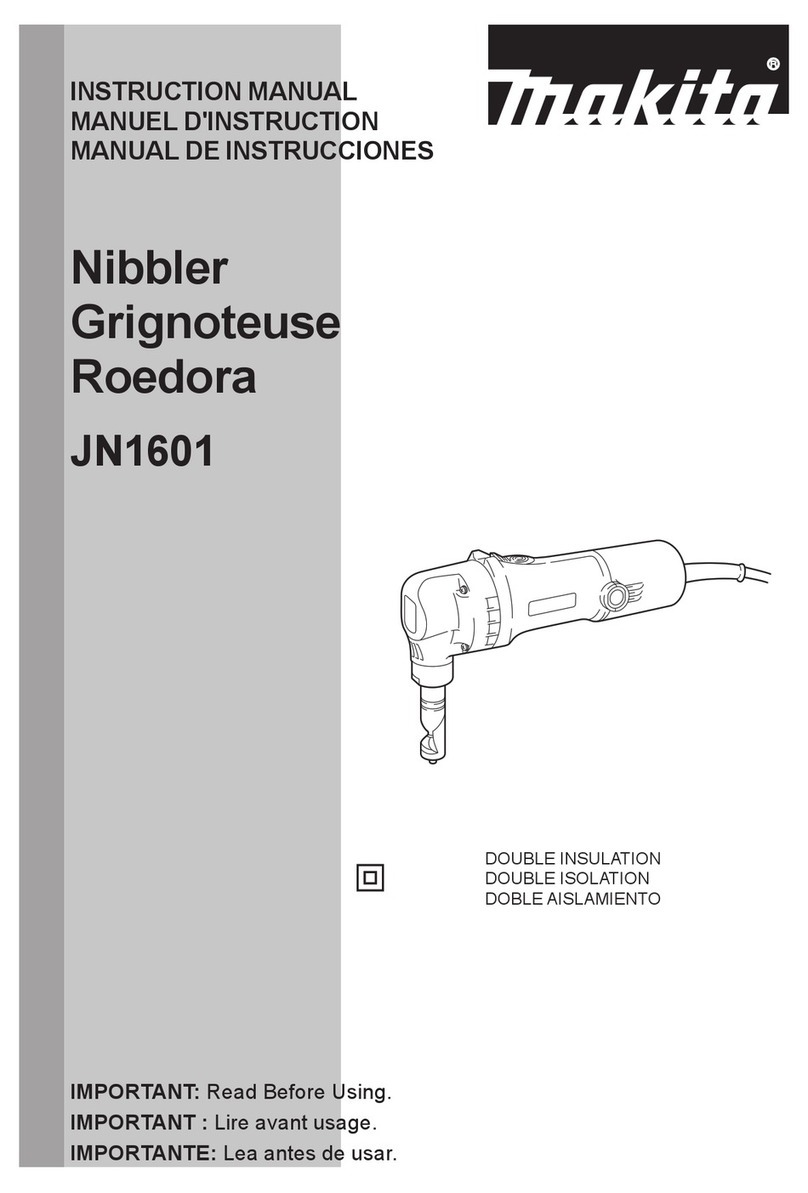
Makita
Makita JN1601 User manual
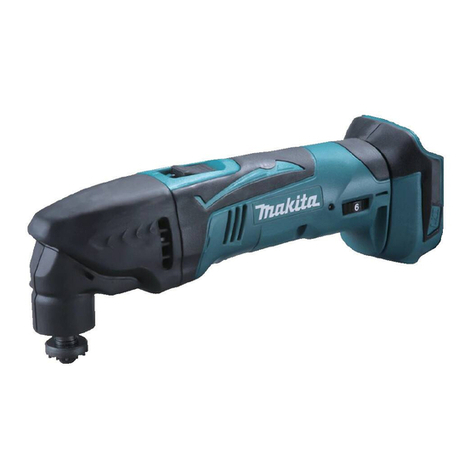
Makita
Makita DTM40 User manual

Makita
Makita UP100D User manual
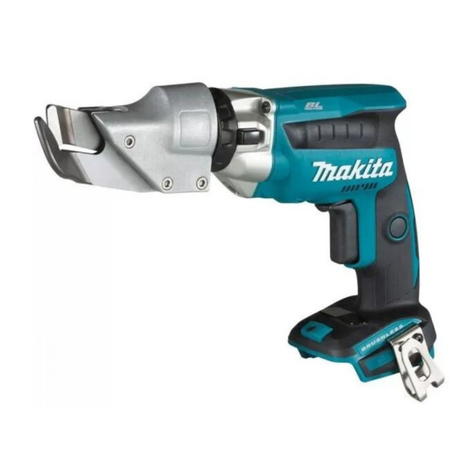
Makita
Makita DJS131Z User manual
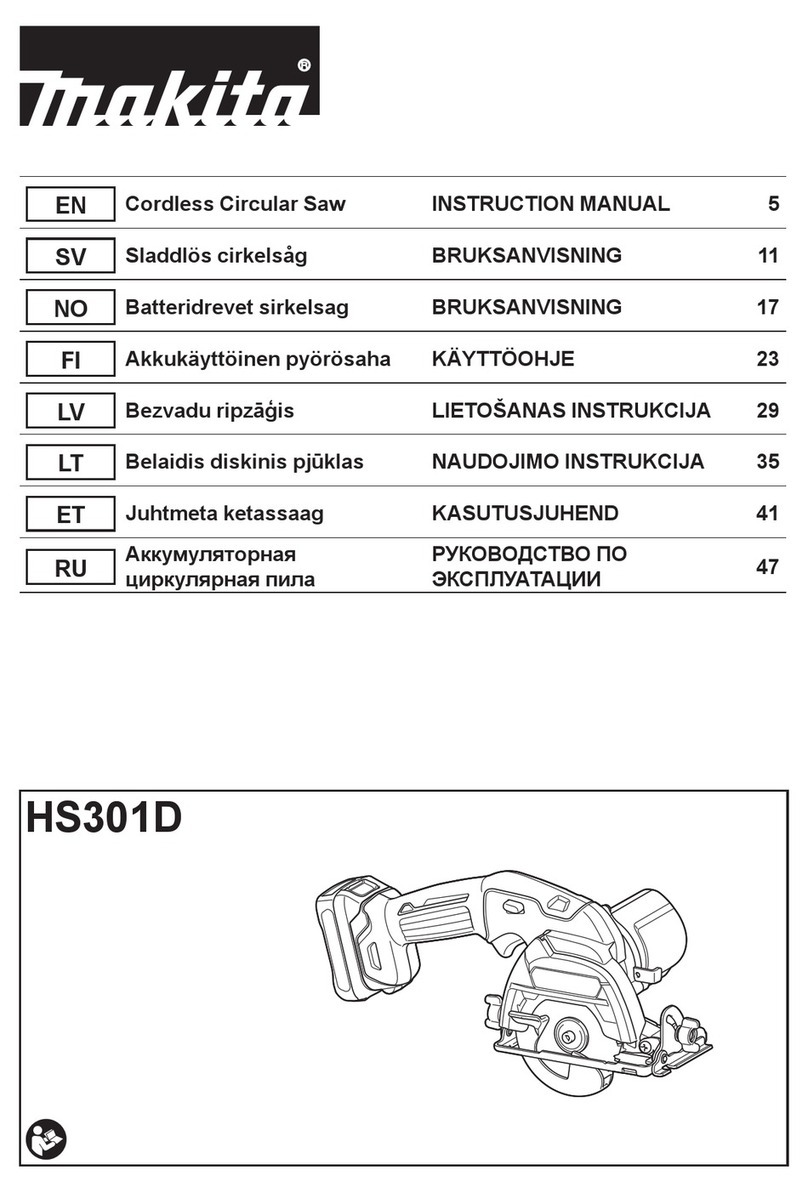
Makita
Makita HS301D User manual
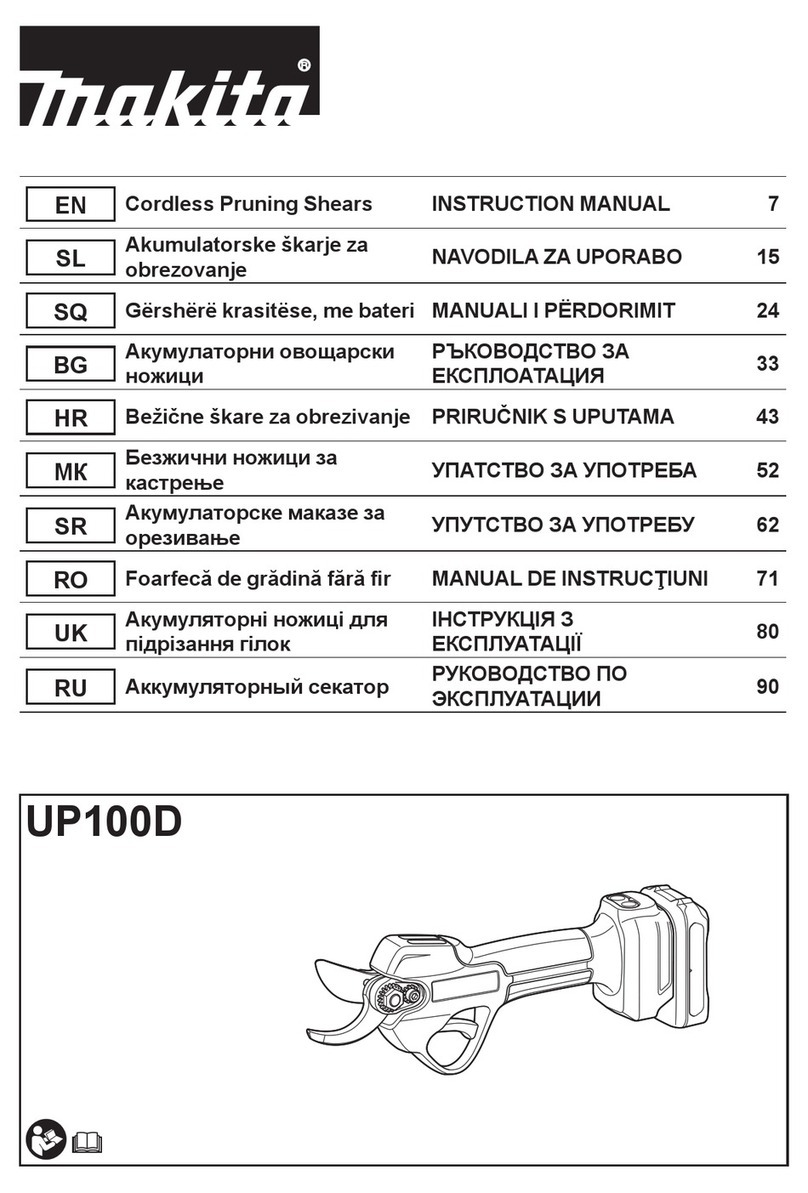
Makita
Makita UP100D User manual
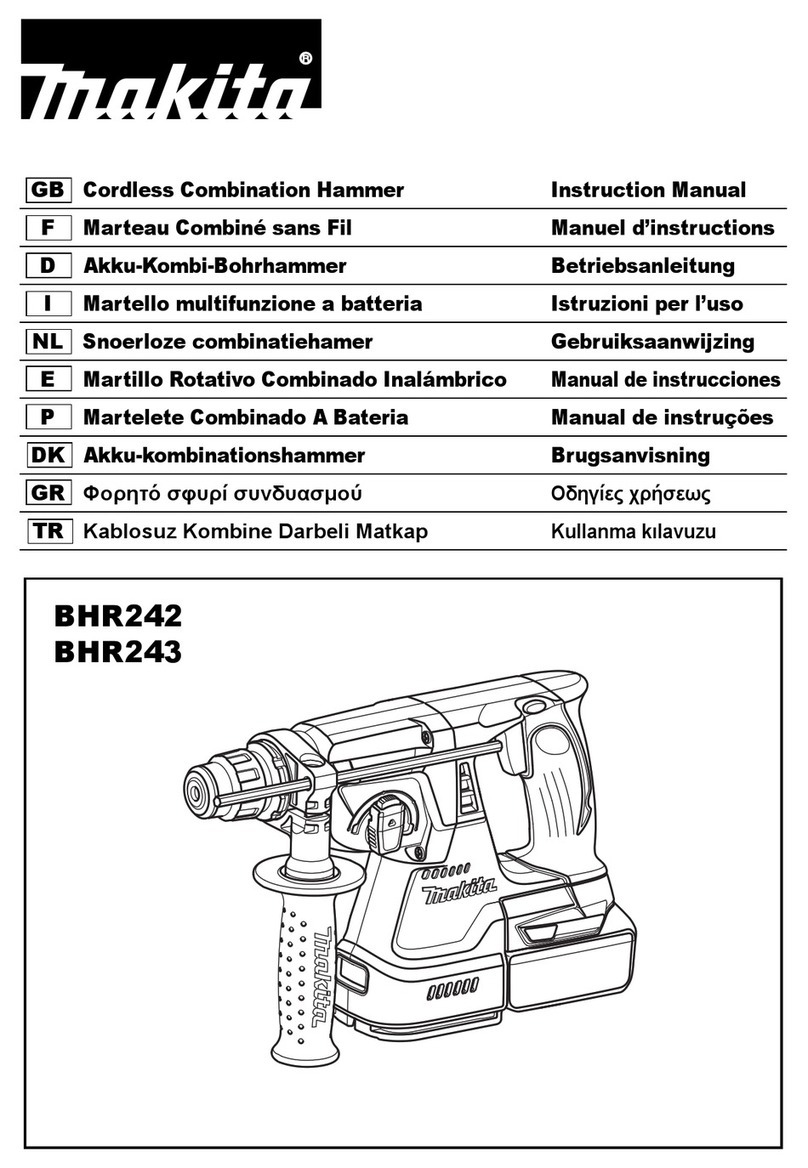
Makita
Makita BHR243 User manual
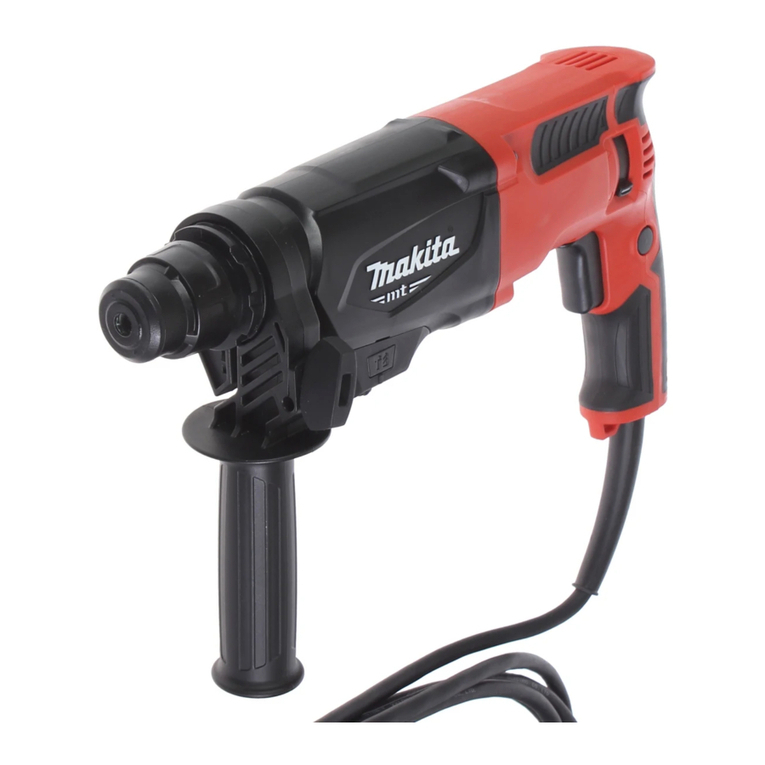
Makita
Makita M8701 User manual
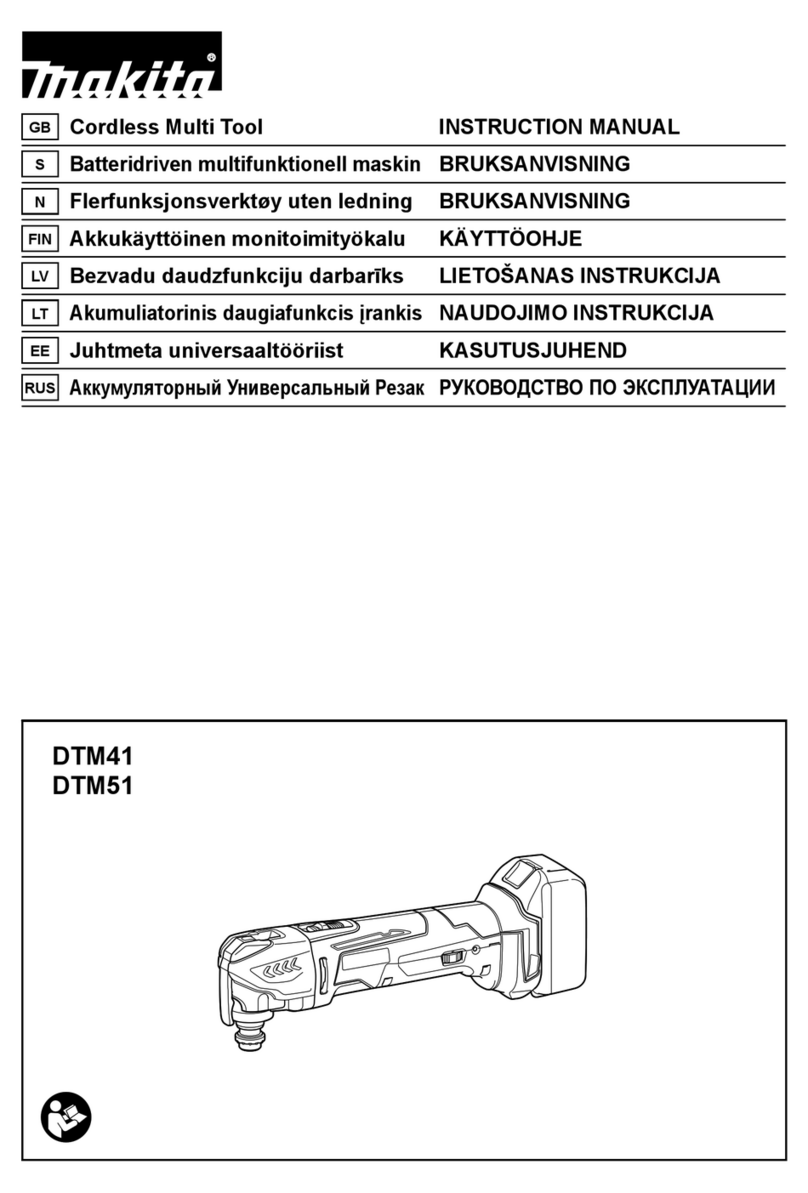
Makita
Makita DTM41 User manual
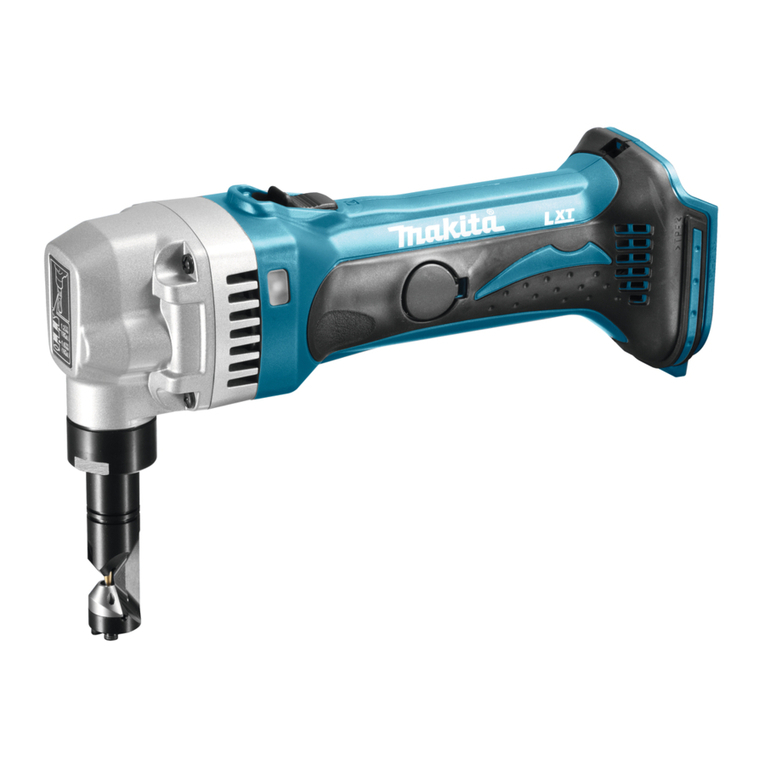
Makita
Makita BJN160 User manual
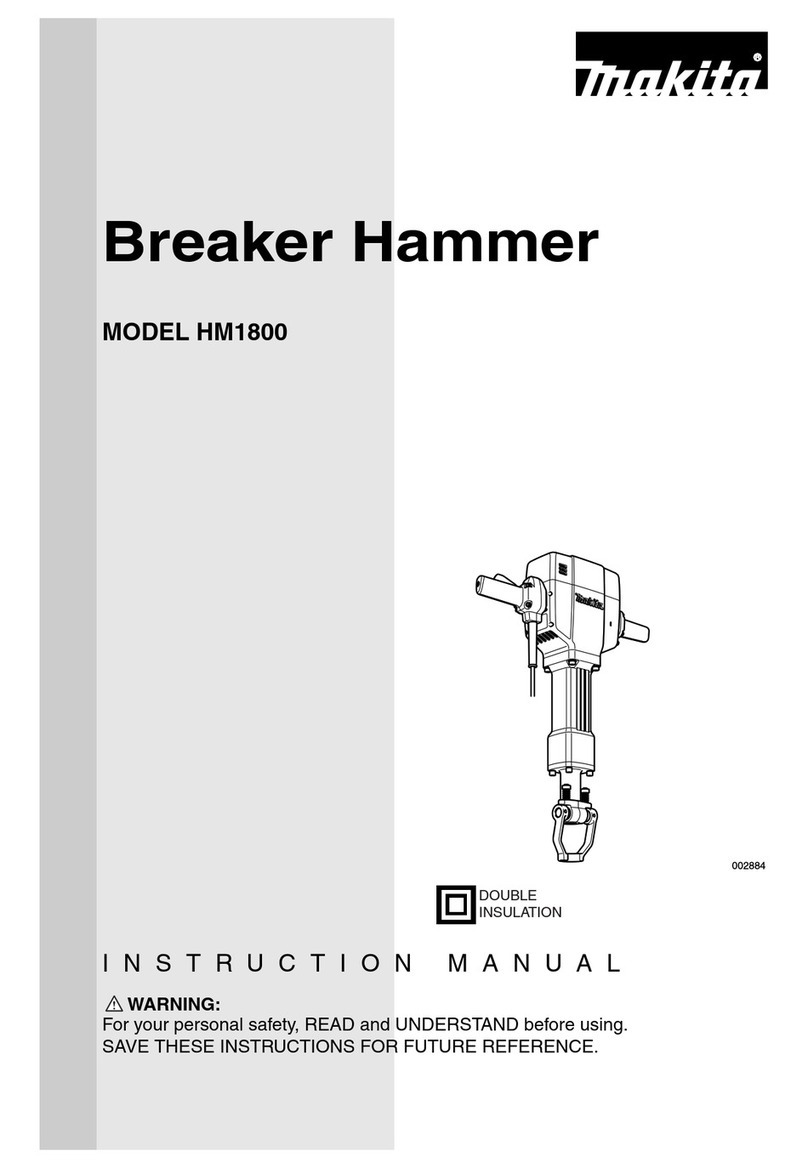
Makita
Makita HM1800 User manual
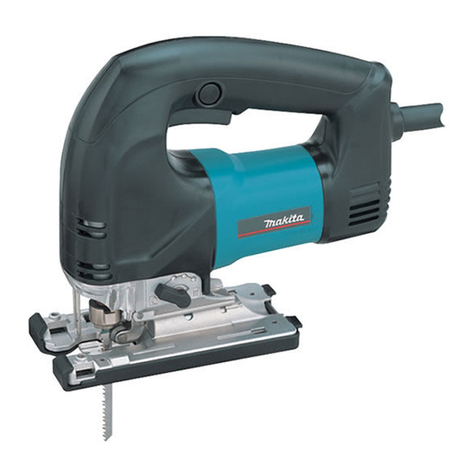
Makita
Makita 4340FCT User manual
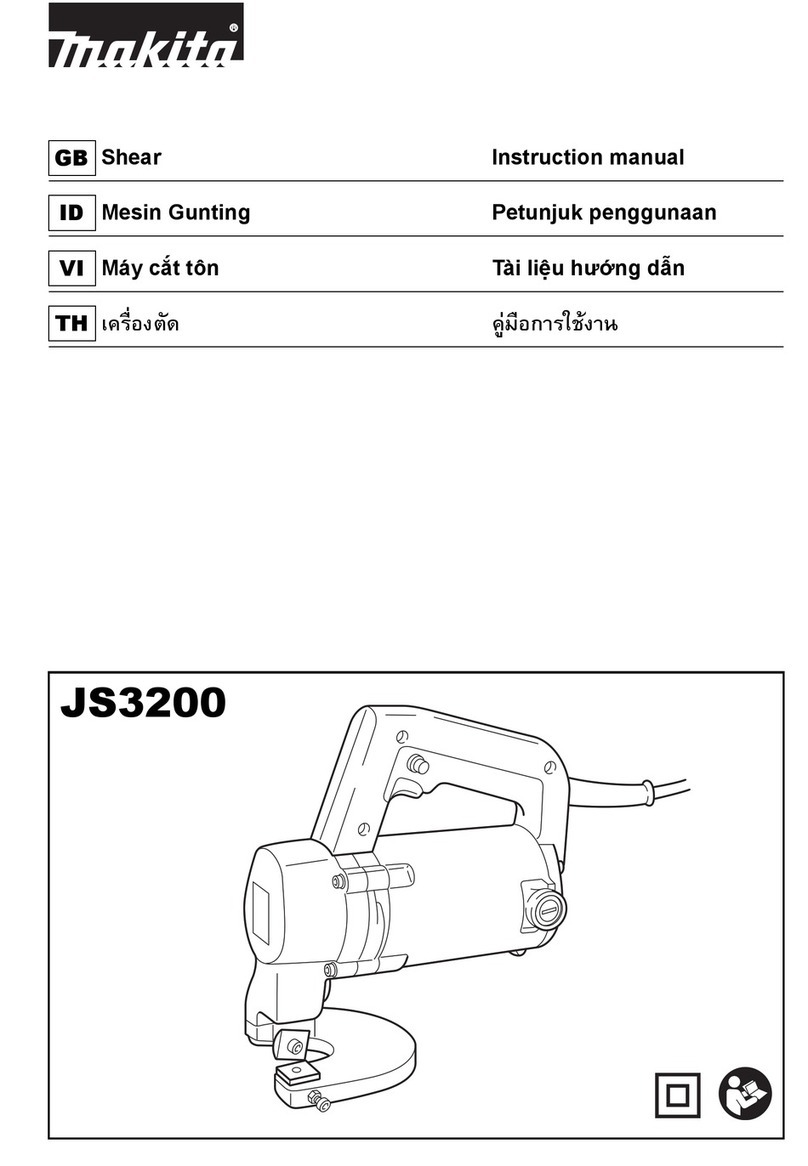
Makita
Makita JS3200 User manual
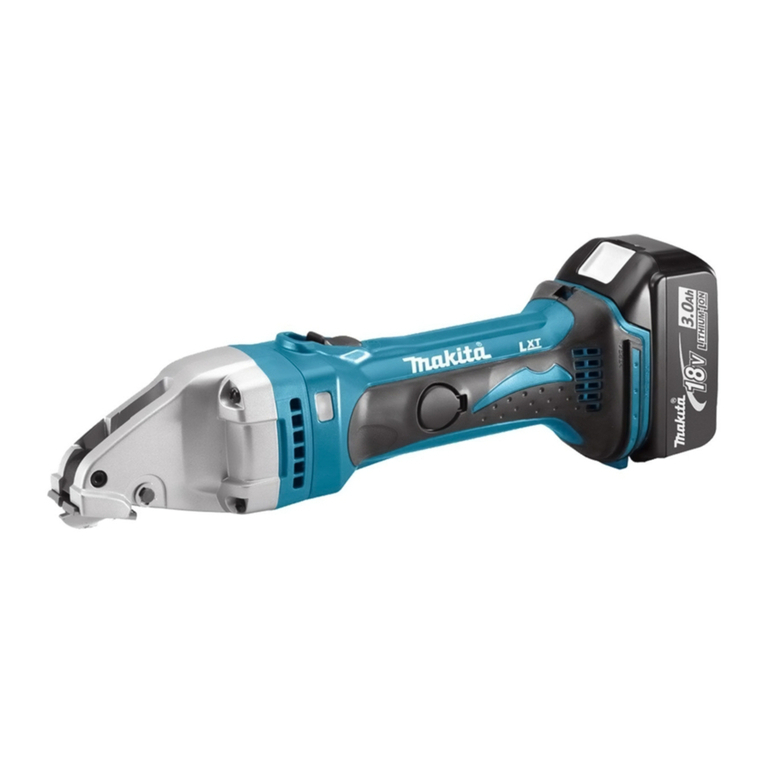
Makita
Makita DJS161 User manual

Makita
Makita Makstar BVR340 User manual
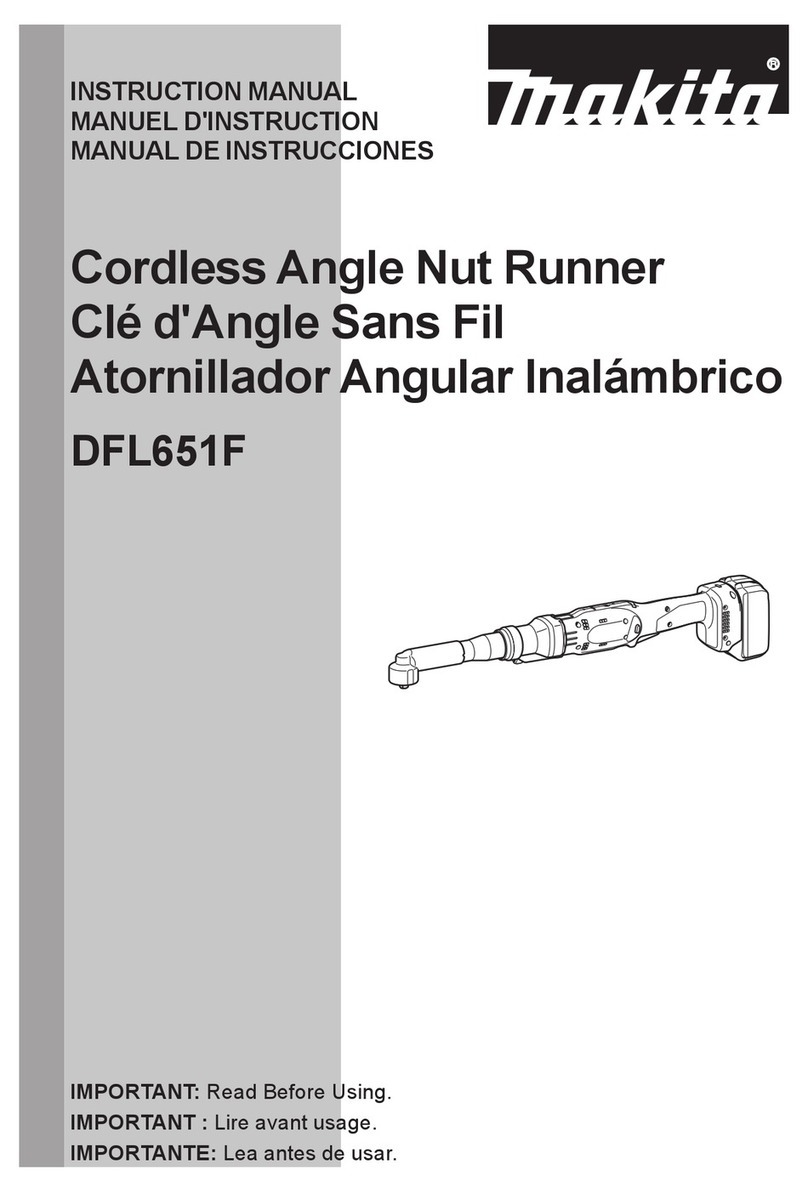
Makita
Makita DFL651F User manual

Makita
Makita DTW284 User manual
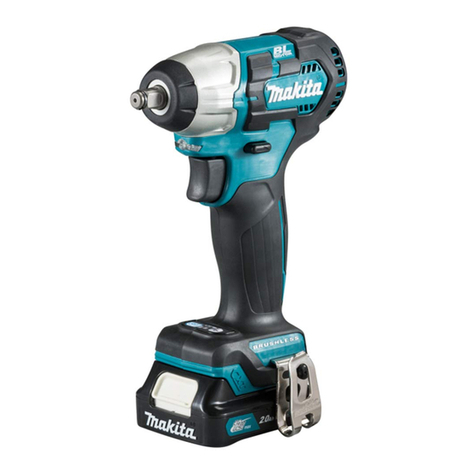
Makita
Makita TW160DZJ User manual

Makita
Makita TW060D User manual
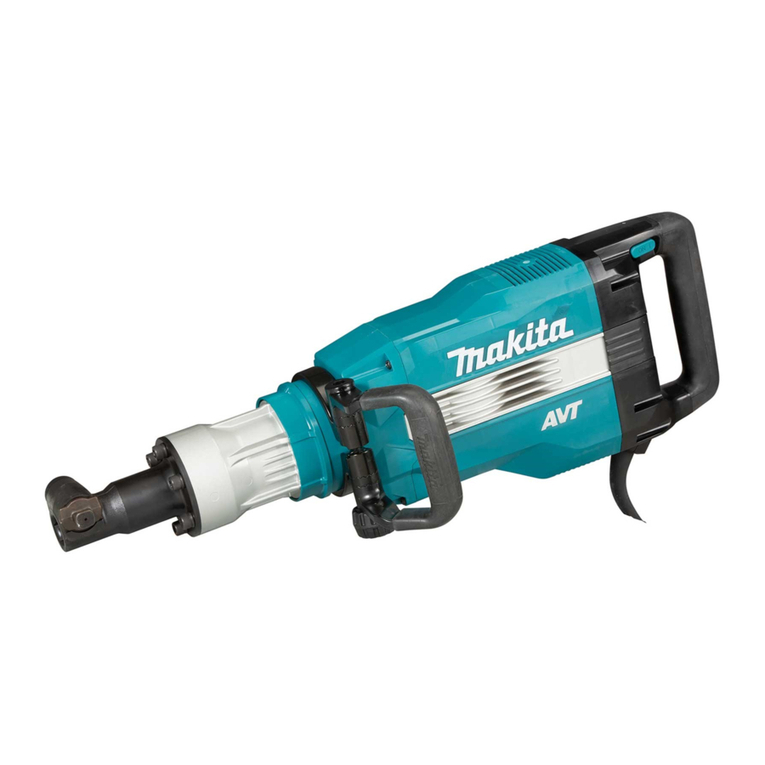
Makita
Makita HM1511 User manual

